Home > EXPERIENCES > FESTIVALS IN BHAKTAPUR
)
EXPERIENCES
Festivals in Bhaktapur
Bhaktapur, a city steeped in history and culture, celebrates a myriad of vibrant festivals throughout the year. From Krishna Janmashtami’s sacred oil lamp processions to the grand spectacle of Biska Jatra, these festivals honour deities, mark the changing seasons, and showcase the rich traditions of the Newar community.
S. No. | Month | Festivals |
|---|---|---|
| 1 | January | Madhav Narayan, Samyak Dan, Navadurga |
| 2 | February | Sila Chahre |
| 3 | March | Holi |
| 4 | April | Biska Jatra |
| 5 | May | Chandeswori Jatra |
| 6 | June | Sithi Nakha, Bhagasti |
| 7 | August | Gunhi Punhi, Sa Paru, Krishna Janmashtami, Gathamuga Charhe, Gunla Parva |
| 8 | September | Teej, Indra Jatra |
| 9 | October | Mohani, Swanti |
| 10 | November | Saki Mana Punhi |
| 11 | December | Yomari Punhi |
MADHAV NARAYAN
A Month of Devotion, Purification, and Sacred Rituals for Lord Vishnu
Madhav Narayan is a significant deity in Bhaktapur, celebrated during a month-long festival from Poush Shukla Purnima to Magh Shukla Purnima. The festival involves fasting, rituals, and a pilgrimage to various holy sites, with devotees gathering at Hanuman Ghat to worship. Madhav Narayan Temple, located at Taumadhi Square, is an important site where offerings are made, particularly for blessings of offspring. The festival is marked by unique practices such as bathing in the river and communal gatherings, reflecting the deep spiritual traditions of the region.
The Kalasha Yatra during the Madhav Narayan festival holds significant spiritual importance. It involves devotees carrying sacred pots filled with water from the confluence of rivers, symbolising purification and devotion. During the Yatra, participants perform a circumambulation of significant temples, chanting mantras and making offerings. The kalashas, designed with holes and straws, allow water to sprinkle as blessings when twirled. This ritual embodies communal faith and spiritual connection, enhancing the festival's significance as a time for devotion to Lord Vishnu, particularly in Bhaktapur. During the Madhav Narayan festival in Bhaktapur, devotees engage in a unique ritual known as Silamantulegu, where they roll on large pieces of white cloth unrolled by women. This practice symbolises devotion and humility, as participants roll towards the Hanumante River after taking a holy bath. The festival involves a month-long fast, with devotees waking early, performing rituals, and reciting tales of Lord Madhav Narayan and Goddess Swasthani. The rolling serves as a form of prostration, demonstrating deep reverence for the deities worshipped during this significant Hindu event.
13 January 2025 to 12 February 2025 (approx. depends upon the new lunar calendar)

Lorem ipsum dolor sit amet, consectetur adipiscing elit
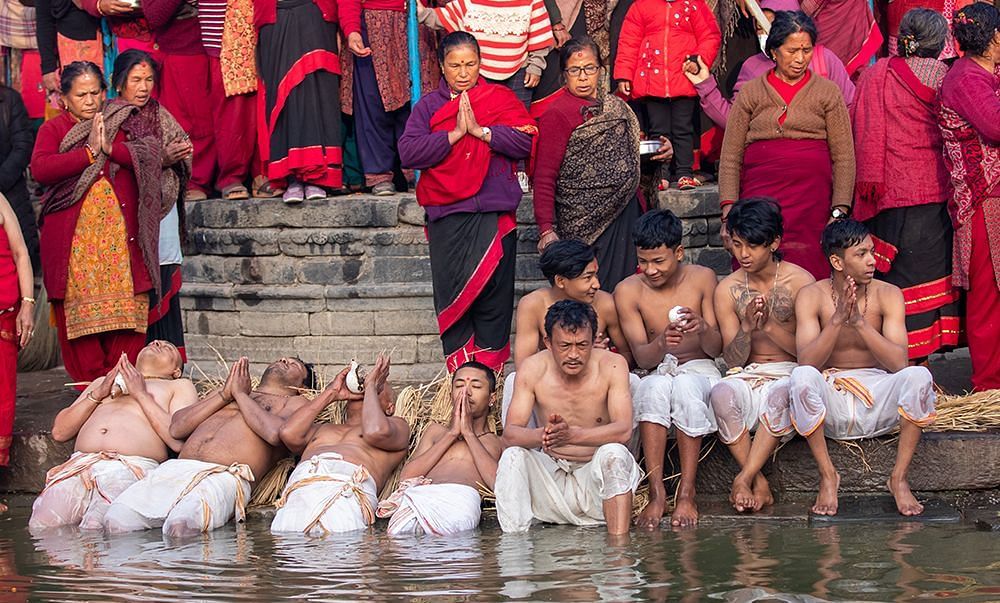
Lorem ipsum dolor sit amet, consectetur adipiscing elit
SAMYAK DAN
The Ultimate Act of Generosity in Buddhism, Honouring Dipankara Buddha
Samyak Dan is an annual Buddhist festival celebrated in Bhaktapur, Nepal. It takes place at Na Pukhu each year during Maghe Sankranti. The festival especially honours Dipankara Buddha, who predicted Lord Sakyamuni Buddha's enlightenment in a previous lifetime. During the event, the five Dipankar Buddhas are gathered at Jayakriti Mahavihar (Thathu Bahi). Before this, a series of rituals occur, such as the act of Laswa Wanegu, where two buddhas from Jayakriti Mahavihar and Bauddha Samakrit Vihar go to Bhaktapur Durbar Square to welcome the other three buddhas who come from Prasannasheel Vihar, Mangaldeep Vihar and Chatur Varna Mahavihar.
After the conjunction of all these buddhas, they go directly to the Thatu Bahi, where the priests welcome them by washing their feet in an act called Tuti Lichaayekegu. Thereafter, the buddhas are placed in a row to begin the Samyak dan. Along with the Buddhas, the other four Samyak Buddhas, the priests, and then the other Shakyas and Bajracharyas take their place to receive the dan (donation) from devotees. Special delicacies like a type of laddu made from roti and sakhkar are prepared and offered. The Samyak Dan is considered the highest form of alms giving according to the Kapisa Contribution Sutra. It is a grand, systematic, and spectacular event organised by the Samyak Mahadan Management Support Committee in Bhaktapur.
14 January 2025 (approx. depends upon the new lunar calendar)
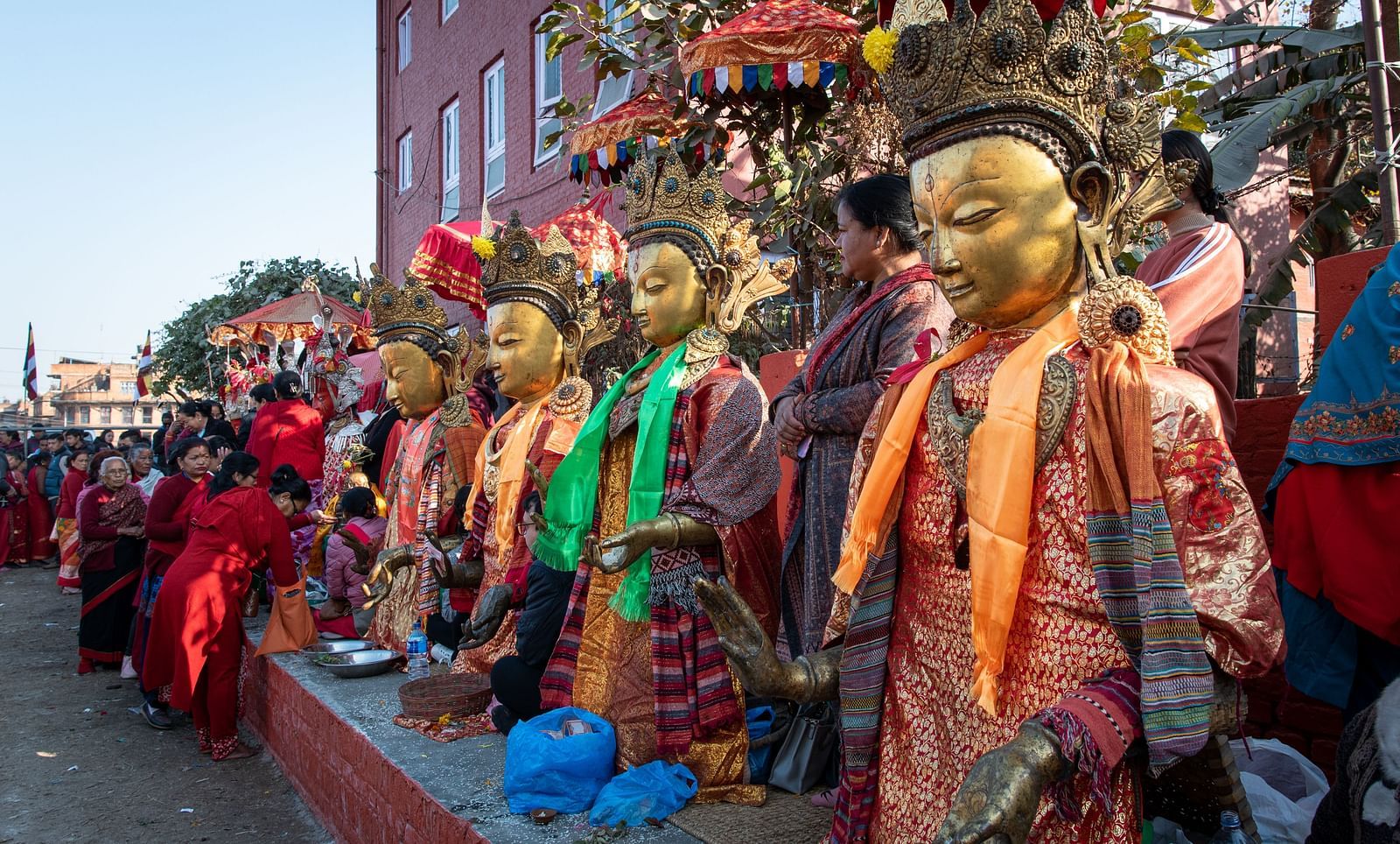
Lorem ipsum dolor sit amet, consectetur adipiscing elit
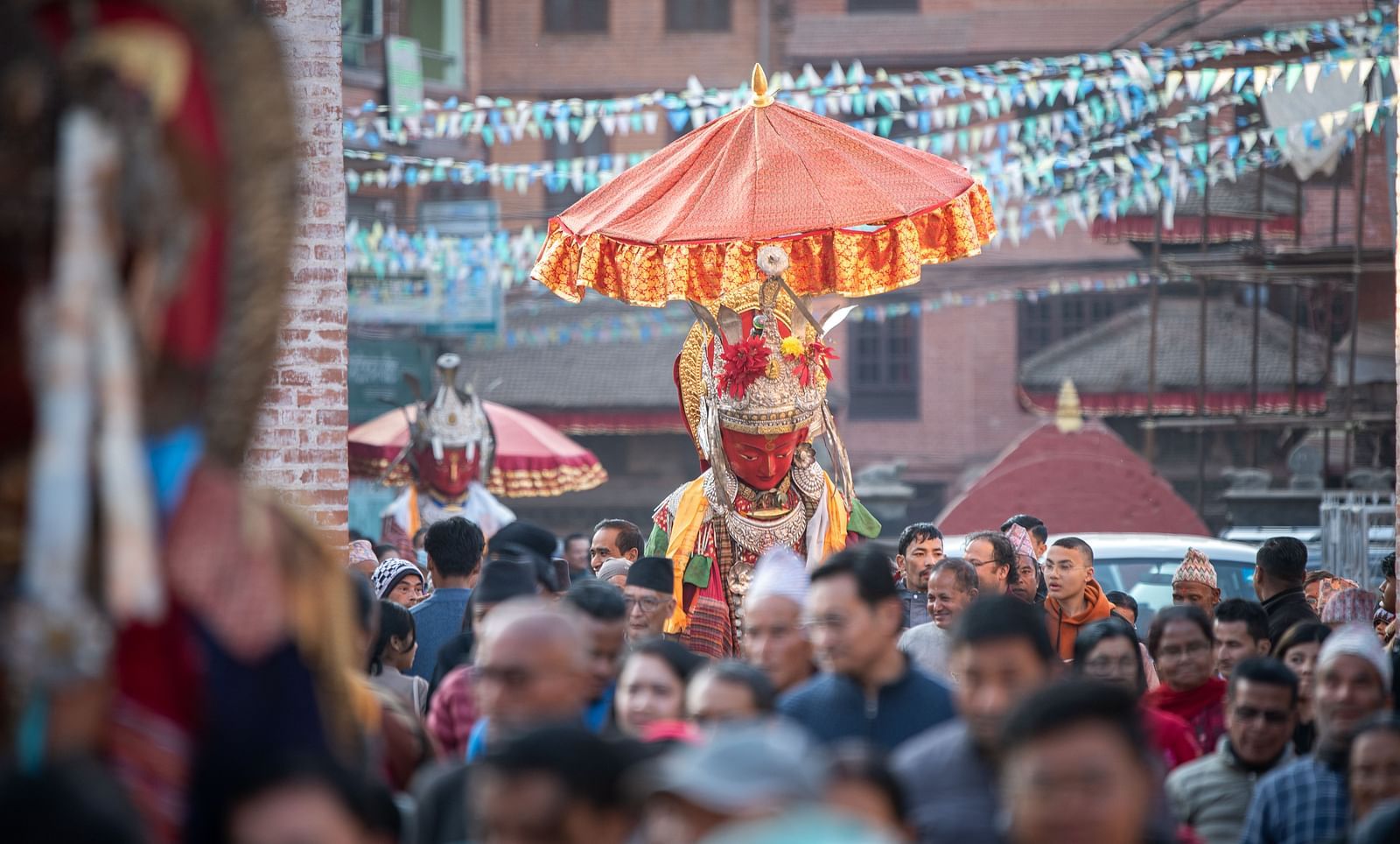
Lorem ipsum dolor sit amet, consectetur adipiscing elit
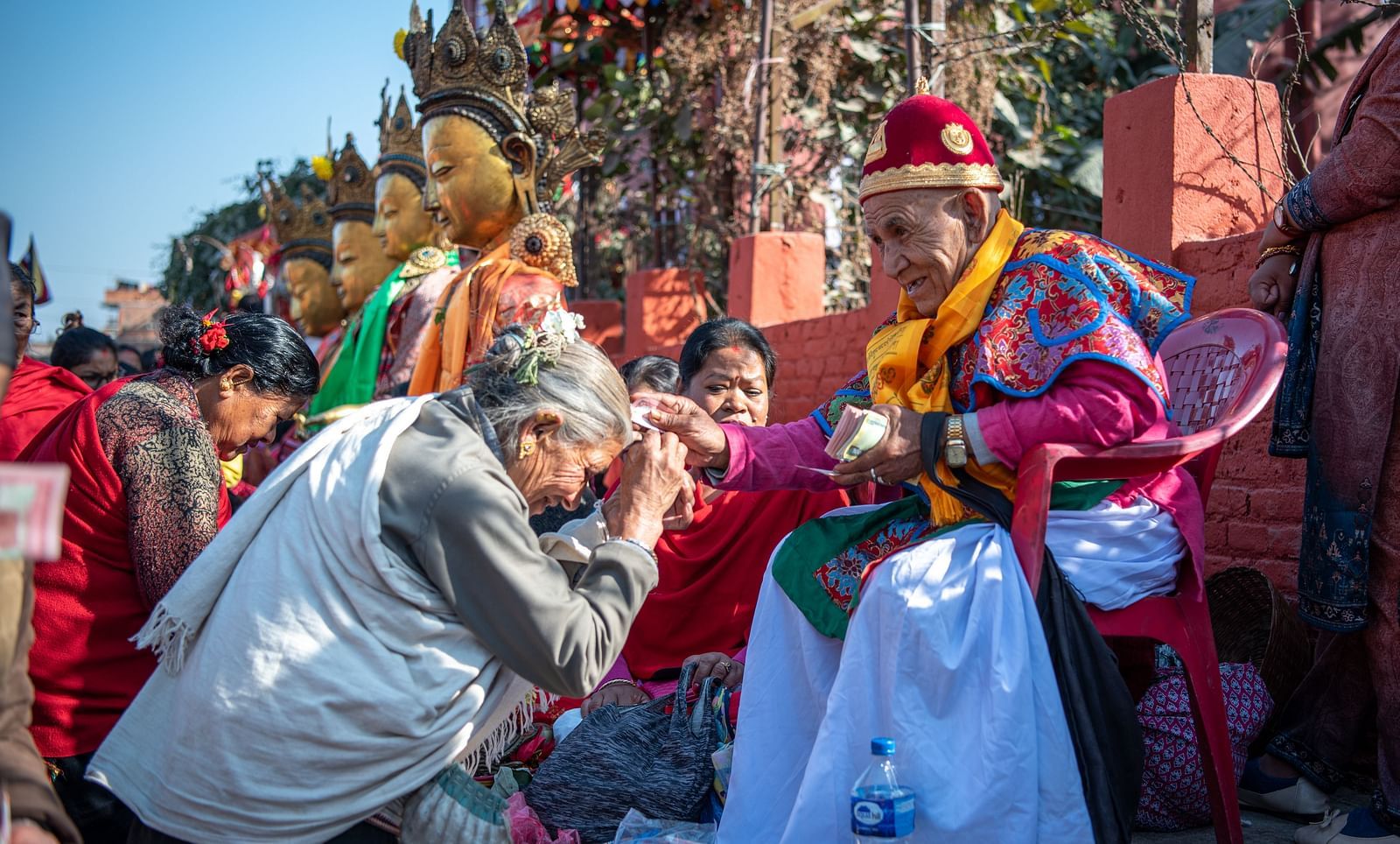
Lorem ipsum dolor sit amet, consectetur adipiscing elit
NAVADURGA
Ancient Dances and Sacred Masks Breathe Life into Bhaktapur’s Enduring Traditions
The Navadurga festival in Bhaktapur is a vibrant celebration involving the Navadurga Naach, a traditional masked dance representing different forms of the Goddess Durga. This unique festival, orchestrated according to the Newa lunar calendar, showcases a troupe of dancers from the Banmala community wearing large, ritualistic masks. The festival includes various rituals, culminating in the cremation of the masks, symbolising a cycle of death and rebirth. The Navadurga dance is both a cultural expression and a vital part of the community's identity, reflecting the intertwining of tradition and modernity.
The masks for the Navadurga dancers are crafted by artisans from the Chitrakar caste, starting about four weeks before Dashain. The process begins with sourcing dark clay, guided by elders from the Prajapati caste. The masks are intricately painted and adorned, with crowns made by the Tamrakar caste. Once completed, the masks undergo a ritual where a priest imbues them with life using tantric practices. This sacred process transforms the masks into vessels for the deities they represent, culminating in their display and eventual ceremonial burning at the festival's end. Training for the dance lasts one to two months, with dancers practicing their routines and familiarising themselves with the masks. The dancers, primarily from the Banmala community, carry their masks and paraphernalia to performance sites, enduring physical challenges throughout the festival.
Starts on 15 January 2025 (approx. depends upon the new lunar calendar and other dates shall be provided a few days later)
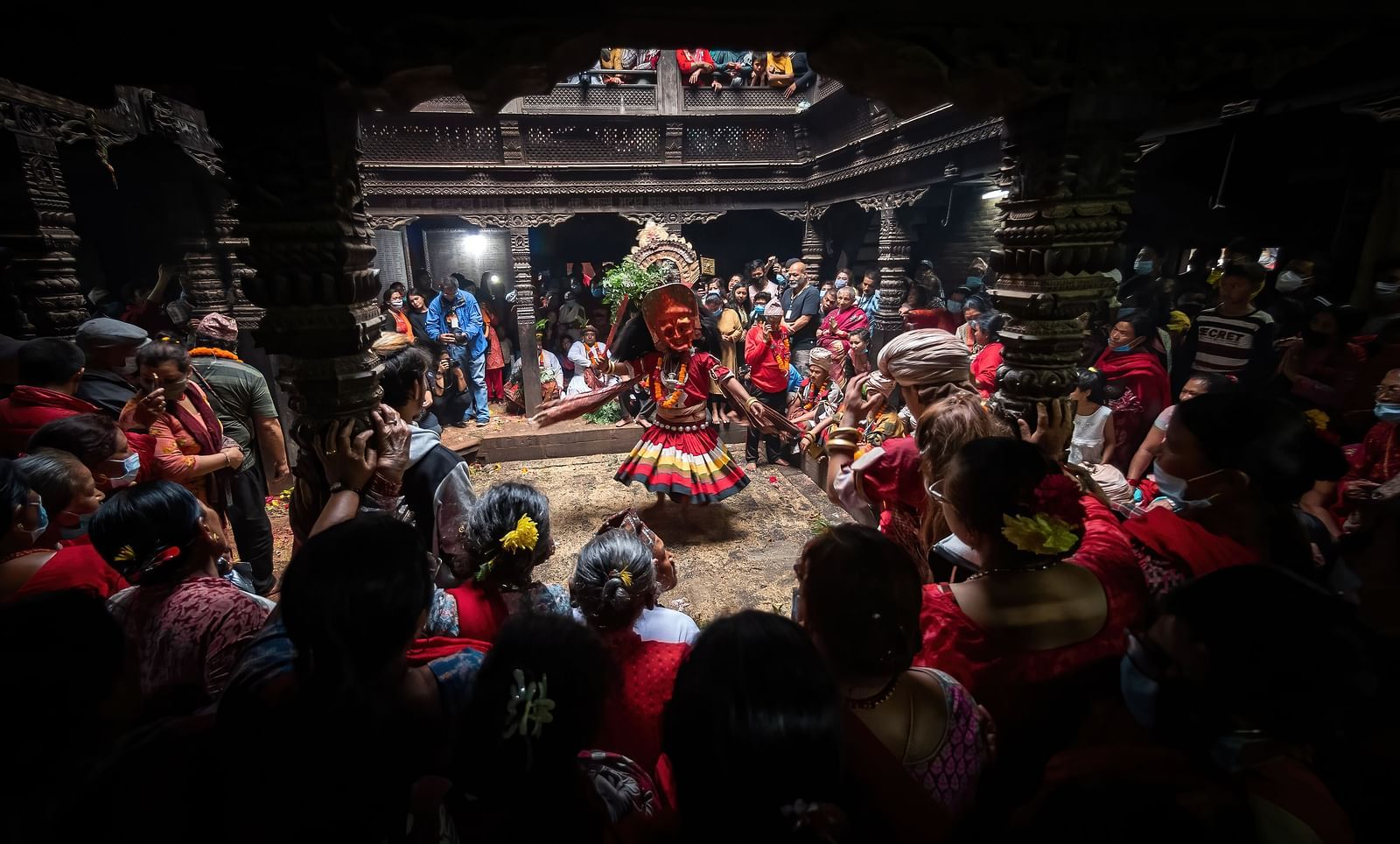
Lorem ipsum dolor sit amet, consectetur adipiscing elit
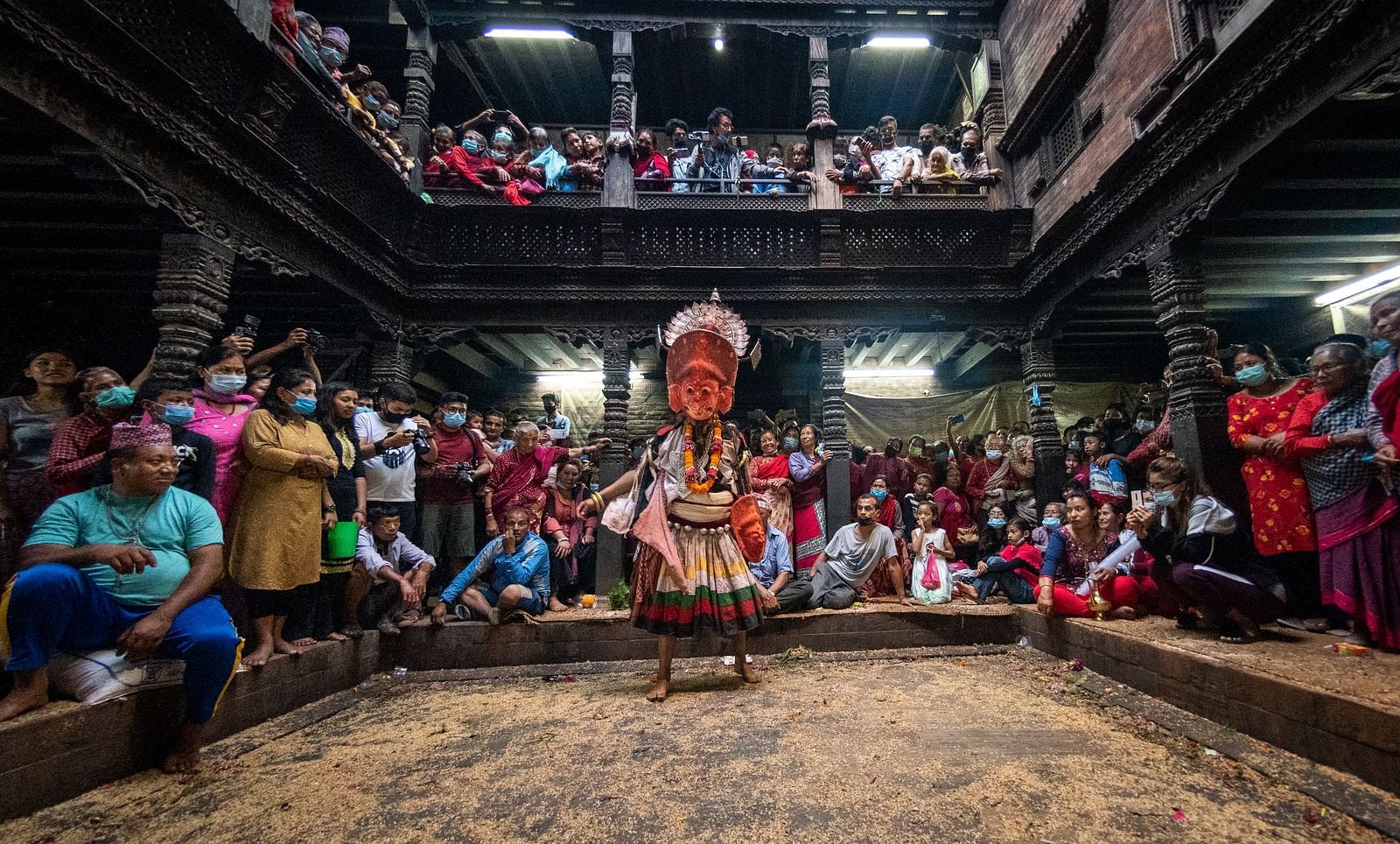
Lorem ipsum dolor sit amet, consectetur adipiscing elit
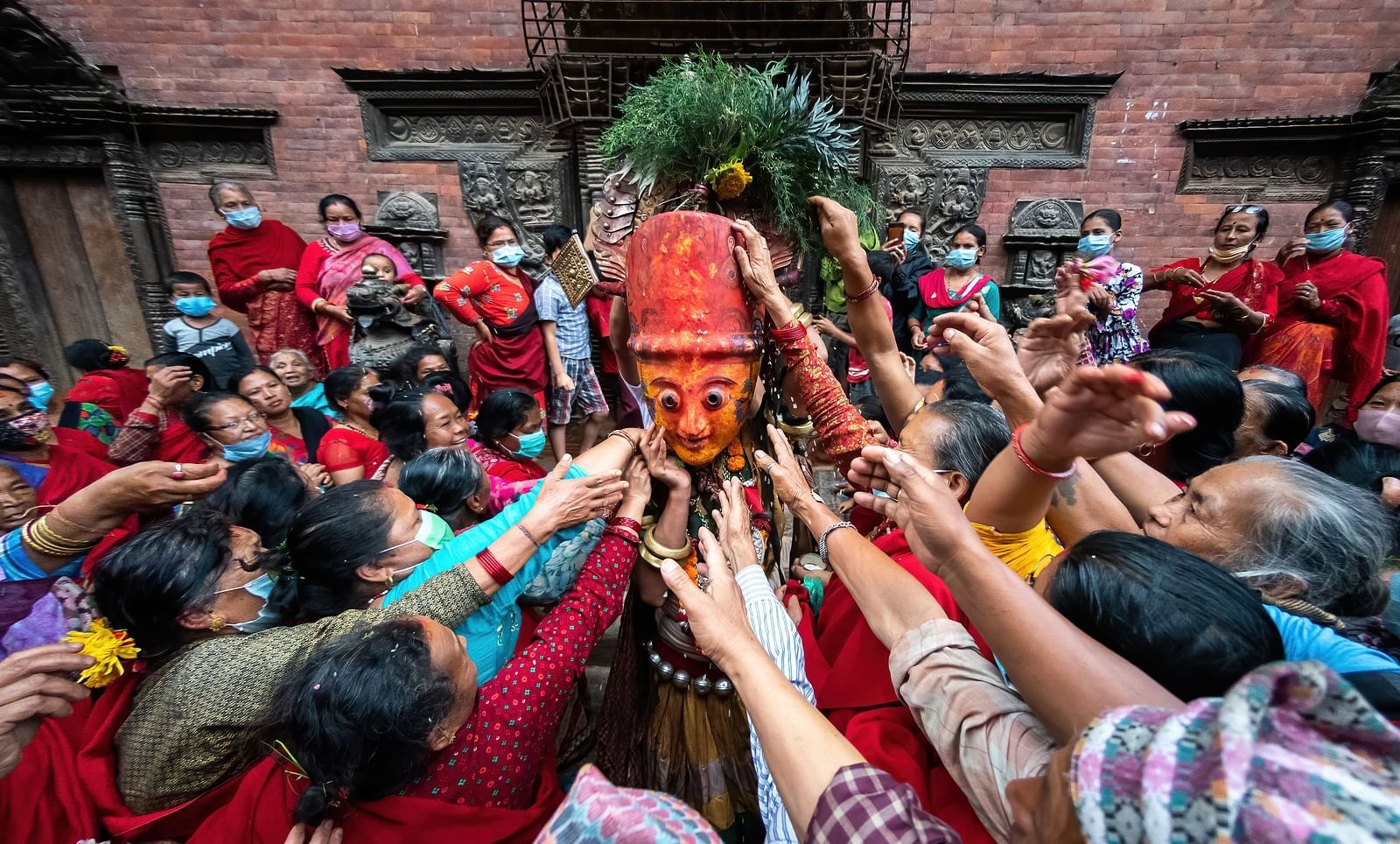
Lorem ipsum dolor sit amet, consectetur adipiscing elit

Lorem ipsum dolor sit amet, consectetur adipiscing elit
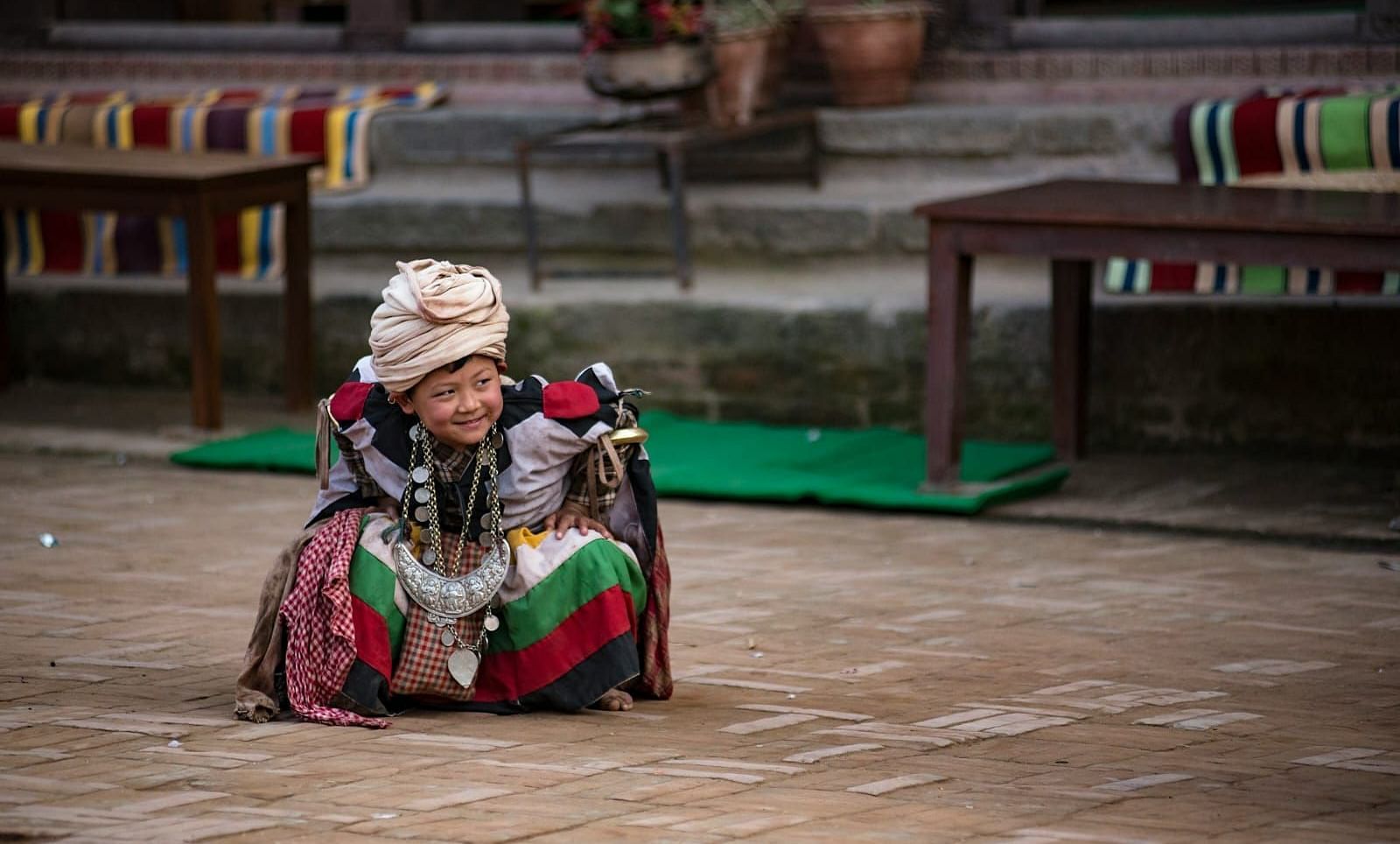
Lorem ipsum dolor sit amet, consectetur adipiscing elit
SILA CHAHRE
A Night of Devotion and Spiritual Renewal
'Sila Chahre', also known as 'Maha Shivaratri', is a significant Hindu festival celebrated primarily by the Newar community in Bhaktapur and the Kathmandu Valley. It honours Lord Shiva and occurs on the 14th day of the lunar month, coinciding with the waning moon. This lunar phase is considered auspicious for spiritual practices and rituals. The festival takes place in late winter/early spring, when the warming winds herald the arrival of spring. This seasonal transition is seen as a time of renewal and spiritual awakening. During this festival, devotees engage in night-long vigils, prayers, and rituals, seeking blessings for well-being and spiritual growth.
The event is marked by gatherings at various Shiva temples, where participants light bonfires and stay awake throughout the night, reflecting on the legends associated with Lord Shiva's marriage to Goddess Parvati and his cosmic significance. Lord Shiva is the supreme deity in Hinduism, symbolising destruction, transformation, and the cycle of birth and death. Worshipping him during this time is believed to bring blessings and spiritual growth.
26 February 2025 (approx. depends upon the new lunar calendar)
)
Lorem ipsum dolor sit amet, consectetur adipiscing elit

Lorem ipsum dolor sit amet, consectetur adipiscing elit
HOLI
A Vibrant and Colourful Festival of Spring, Unity, and the Victory of Good over Evil
Holi, or Holi Punhi, is a vibrant festival celebrated in Bhaktapur, Nepal, marking the arrival of spring and the victory of good over evil. Unique to this city, the festival involves the installation of a ceremonial wooden pole symbolising the phallus of Bhimsen, accompanied by traditional Newari songs. Celebrations include throwing coloured powders, communal gatherings, and rituals at the Bhimsen Temple, with festivities lasting from Fagun Shukla Ashtami to Purnima. The event fosters unity and joy among participants of all ages.
In Bhaktapur's Holi celebrations, the red cloth with a hole symbolises Draupadi's genitalia from the Mahabharata. A wooden pole representing the phallus of God Bhimsen is ritualistically inserted into this cloth during ceremonies, reflecting themes of fertility and sexuality. This act is part of a larger celebration that includes singing and communal festivities, emphasizing the festival's unique cultural significance in Bhaktapur, which blends mythology with vibrant local traditions.
13 March 2025 (approx. depends upon the new lunar calendar)
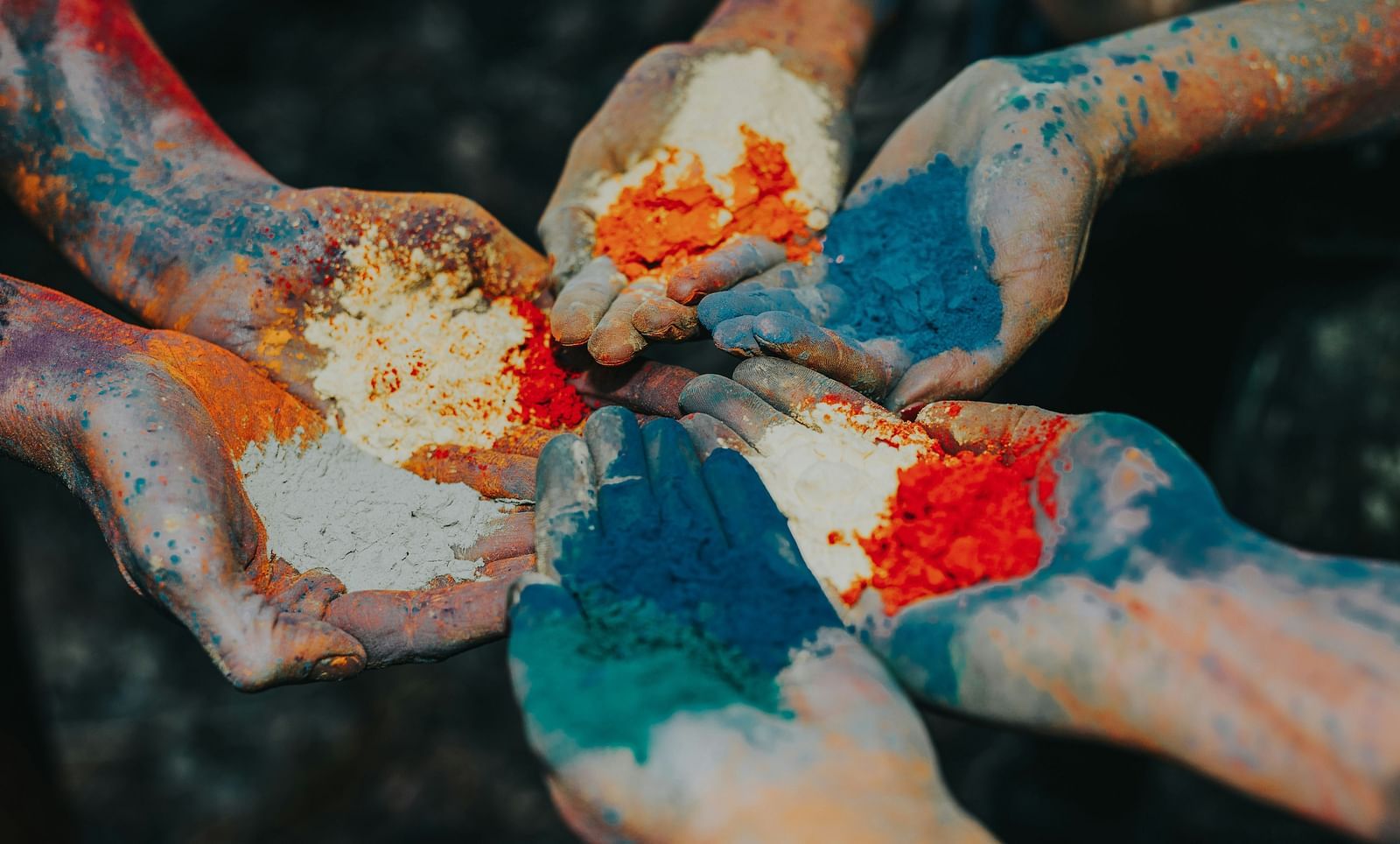
Lorem ipsum dolor sit amet, consectetur adipiscing elit

Lorem ipsum dolor sit amet, consectetur adipiscing elit
BISKA JATRA
Bhaktapur's Grand Celebration of Heritage, Prosperity, and New Beginnings
Biska Jatra stands as one of Bhaktapur’s most revered festivals, embodying significant cultural and historical value. Celebrated by the Newar community of Bhaktapur, Biska Jatra holds immense popularity and intensity, its exact date varying with the lunar calendar and astrological positions. Aligning with the end and start of the Bikram Sambat calendar year, it commences five days before the year’s end, culminating four days into the new year. Held in mid-April next year (April 10th-April 18th 2025), it marks the welcoming of spring and spans eight nights and nine days, drawing thousands from across the country to Bhaktapur.
Visitors, regardless of ethnic or religious background, flock to Bhaktapur to witness the festivities, believed to bring prosperity and happiness to those who pay homage to the chariots and deities. The festival also seeks to appease God Bhairav, with prayers and offerings made to alleviate suffering. A notable highlight of the Jatra is the ‘Yosing', a towering pole erected on the last day of the month Chaitra, symbolising the downfall of one’s enemies. Following its collapse and the commencement of the Nepali New Year, the festivities continue for four more days, featuring a chariot clashing festival , where devotees assemble and collide the chariots of the God Bhairava and the Goddess Bhadra Kali against each other. Additionally, rituals such as Sindoor Jatra and Tongue-Piercing Jatra add further cultural depth to the celebration.
10 April 2025 to 18 April 2025 (approx. depends upon the new lunar calendar)
)
Lorem ipsum dolor sit amet, consectetur adipiscing elit
)
Lorem ipsum dolor sit amet, consectetur adipiscing elit
)
Lorem ipsum dolor sit amet, consectetur adipiscing elit
CHANDESWORI JATRA
Celebrating Bhaktapur’s Sacred Traditions and Rituals
Chandeswori Jatra, celebrated in Bhaktapur, honours the goddess Chandeswori Ajima. This festival, also known locally as Chasu Puhni, involves rituals like animal sacrifices (Balipuja) and a ceremonial chariot procession through upper half of the city, culminating at the goddess's temple in Chasukhel Tole. The event occurs over two days, starting from Vaisakha Purnima, and coincides with Buddha Jayanti. Its origins trace back to a Lichhavi king's devotion to the goddess, who placed the goddess's statue near his palace for worship, symbolising her support for his reign.
The Tipwa Jatra, held the day before Chandeswori Jatra, holds deep significance as it marks a poignant procession where the idol of Goddess Chandeswori is set on fire. This ritual symbolises the emotional connection of the community to the goddess, often moving participants to tears. The day also involves animal sacrifices (Balipuja) and serves as a precursor to the main festivities. The Kalandan is a unique ritual performed during the Chandeswori Jatra in Bhaktapur. It involves throwing animal meat offerings to the crowd of devotees. Anyone who manages to catch a piece of the thrown meat is considered lucky. The Kalandan symbolises the goddess's blessings and good fortune for the devotees. The Kalandan takes place during the grand procession where the goddess's idol is paraded through the streets of Bhaktapur on a large chariot.
12 May 2025 (approx. depends upon the new lunar calendar)
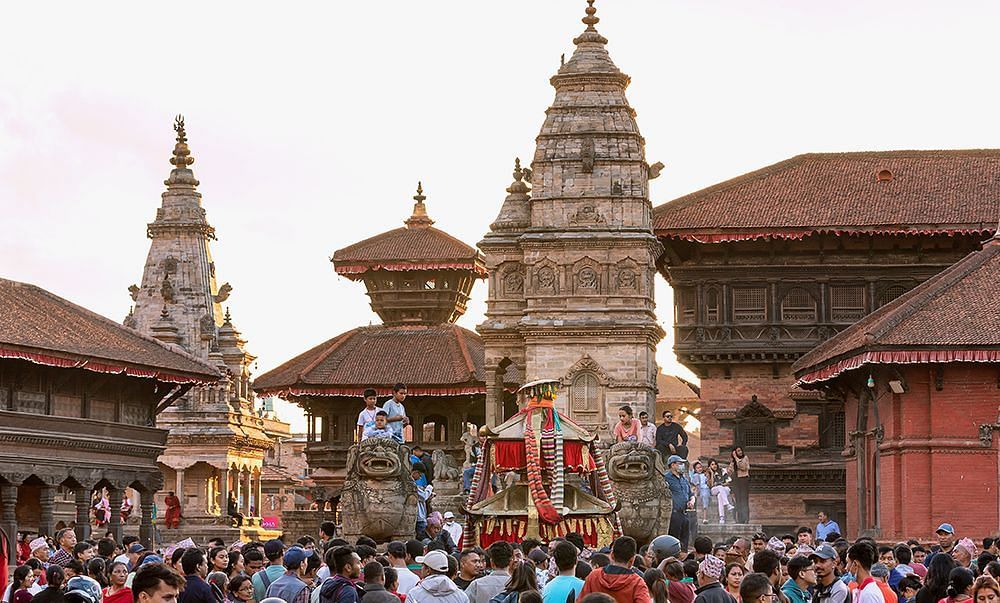
Lorem ipsum dolor sit amet, consectetur adipiscing elit
SITHI NAKHA
A Celebration of Water Conservation and Community Involvement
The Sithi Nakha festival is a significant cultural event celebrated by the Newar community in Nepal. Observed on the sixth day of the waxing moon in the Nepali month of Jeth, this ancient festival emphasizes the importance of water conservation and community bonding, thus, promoting a sense of shared responsibility and collective action.
The highlight of the festival is the cleaning of the water sources, which is a powerful symbol of the community's commitment to preserving their environment. The community engages in rituals and ceremonies to purify and consecrate the water, seeking blessings for a bountiful harvest and good health. Traditional Newari dishes especially 'wo' and 'chatamari', and liquors are served during the festival, which is a testament to the community's deep connection with nature and their commitment to preserving the environment. The Nanee seeks to embrace the values of this ancient wisdom.
1 June 2025 (approx. depends upon the new lunar calendar)

Lorem ipsum dolor sit amet, consectetur adipiscing elit
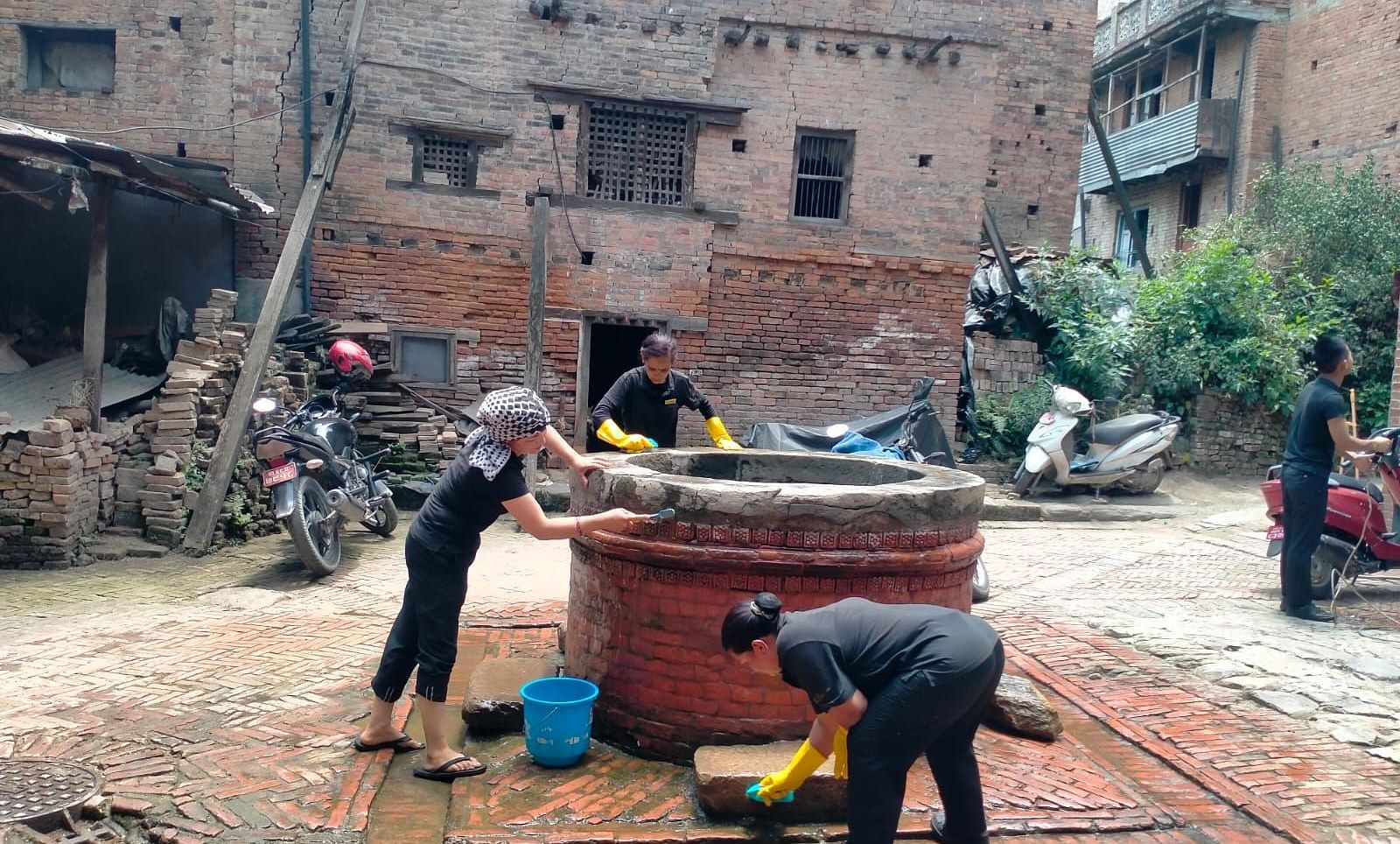
Lorem ipsum dolor sit amet, consectetur adipiscing elit
)
Lorem ipsum dolor sit amet, consectetur adipiscing elit
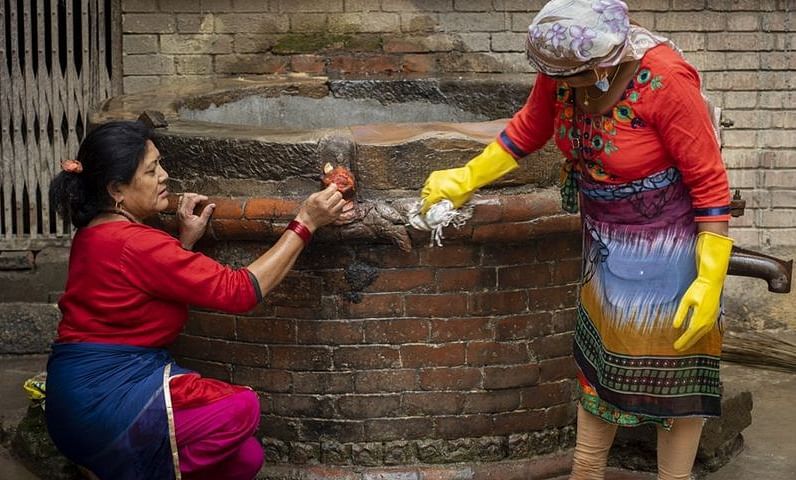
Lorem ipsum dolor sit amet, consectetur adipiscing elit
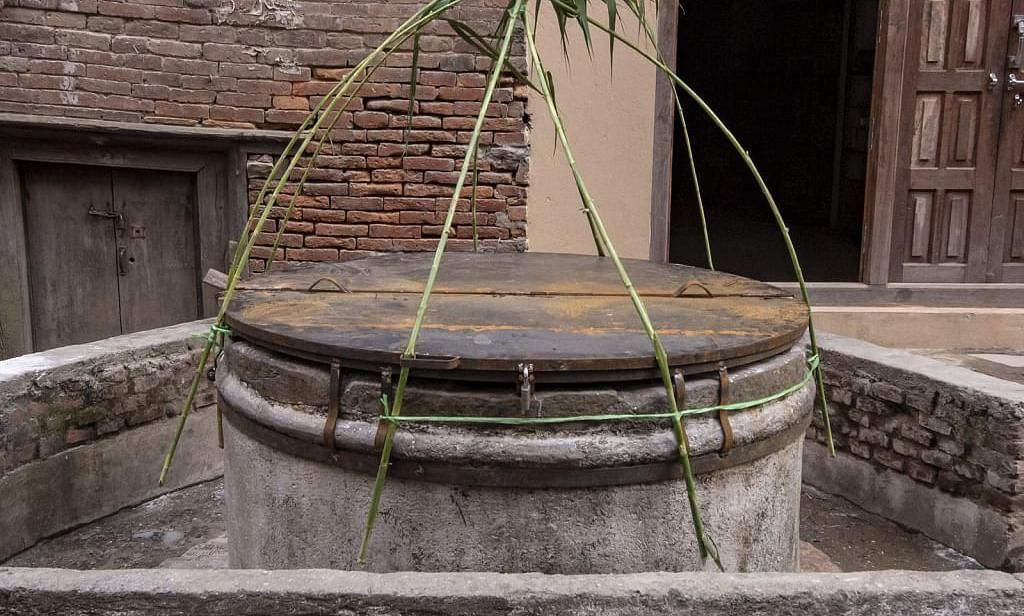
Lorem ipsum dolor sit amet, consectetur adipiscing elit
BHAGASTI
The Day Symbolising the Death of the Gods
The Navadurga Dance is a profound cultural practice that exemplifies the life cycle of living beings, symbolising that everything, including gods and goddesses, has an end. This ritual, sustained by the Nava Durga Gana of Bhaktapur, brings the Navadurga to life during Dashain and culminates with their symbolic death on Bhagasti (Bhalvala Ashtami). The powerful Navadurga deities, who manifest for eight months, see their earthly journey end on this day.
On the day of Bhagasti, the divine tantric energies leave their humanoid bodies and the masks of Navadurga are cremated at Bramhayani. The energies are then believed to be transferred to a special thread worn by Bhaktapur's residents, distributing the power among them. A portion of the ashes is then dispersed into the waters of the Hanumante river, believed to bless the waters that nourish the rice fields. This act marks the end of the deities' earthly presence, and following this, the people of Bhaktapur cease singing bhajans and playing musical instruments until Gatha Muga Charhe. During this period, the city transitions from a hub of festivals and music to a focus on agriculture. Gatha Muga Charhe signals the reincarnation of the God Shiva in the Navadurga Gana. The cycle completes when the thread is removed on Dashami at Bramhayani, and the divine power is transferred back to the new masks made from the previous year's ashes, restarting the Navadurga cycle. This profound ritual underscores the continuous flow of life energy and the cyclical nature of existence.
19 June 2025 (approx. depends upon the new lunar calendar)

Lorem ipsum dolor sit amet, consectetur adipiscing elit

Lorem ipsum dolor sit amet, consectetur adipiscing elit

Lorem ipsum dolor sit amet, consectetur adipiscing elit
GUNHI PUNHI
A Vibrant Celebration of Tradition, Gratitude, and Spirituality in Bhaktapur
Gunhi Punhi, also known as 'Kwati Punhi', is a significant nine-day festival celebrated by the Newar community in Bhaktapur. On the first day, the Newar people consume a soup called Kwati, made from a mixture of nine different types of sprouted beans. Kwati is believed to have medicinal properties and is considered a nutritious dish.
Brahmins tie a sacred thread called 'Doro' or 'Janai' on the wrists of the faithful as a protective measure. During Gunhi Punhi, farmers in Bhaktapur show gratitude to frogs by offering them food, such as rice and kwati. This practice, known as 'Byancha Yata Ja Nakegu', acknowledges the frogs' role in controlling pests that threaten rice crops. The offerings symbolise appreciation for the rain and the frogs' contributions to agricultural health. On the second day, known as Sa Paru, locals who lost a family member that year dress up as cows and parade through the streets, as cows are believed to help the lost souls pass into heaven. The final day coincides with Krishna Janmashtami, celebrating the birth of Lord Krishna, marked by various dances and festivities throughout the valley.
9 Aug 2025 (approx. depends upon the new lunar calendar)
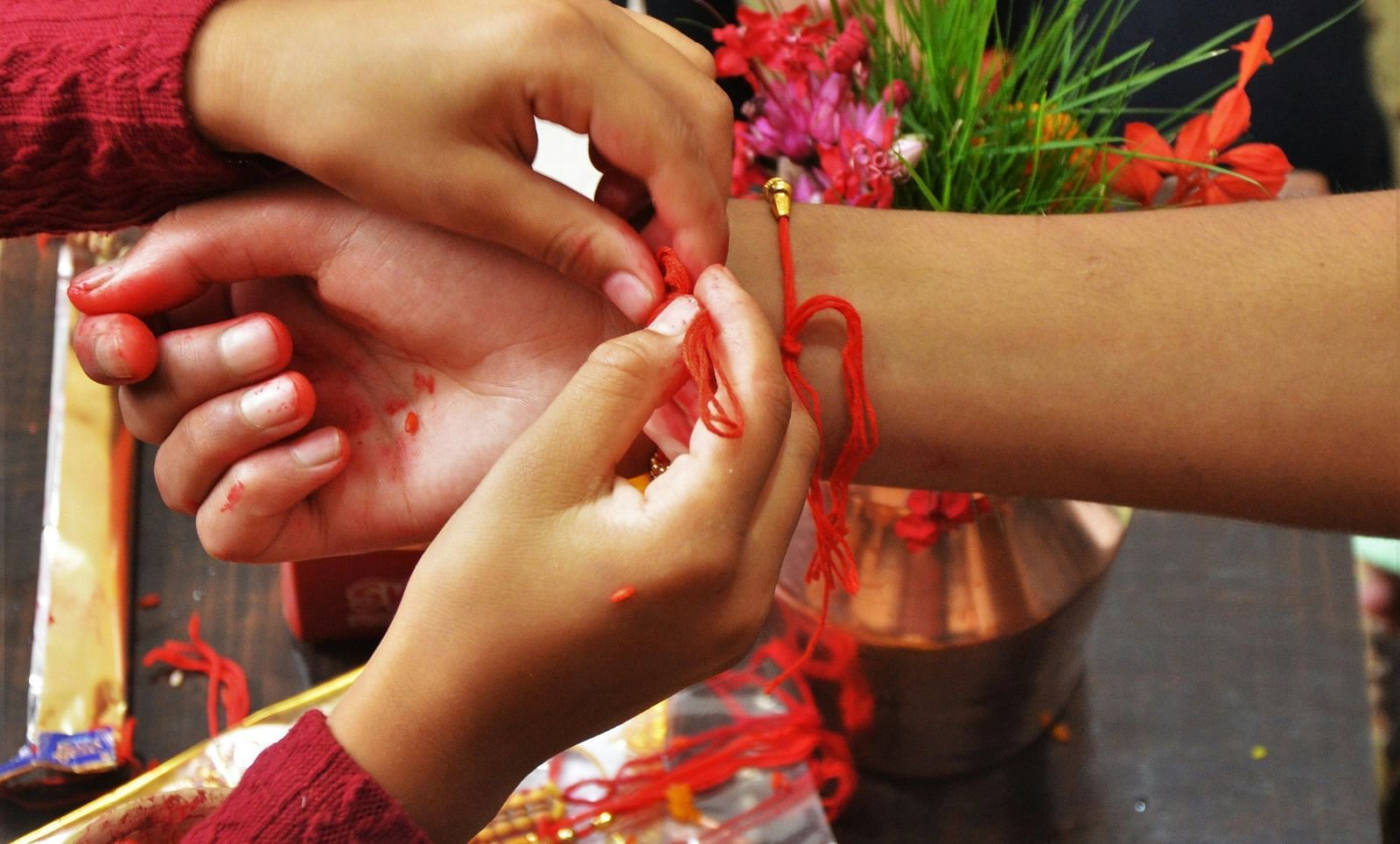
Lorem ipsum dolor sit amet, consectetur adipiscing elit
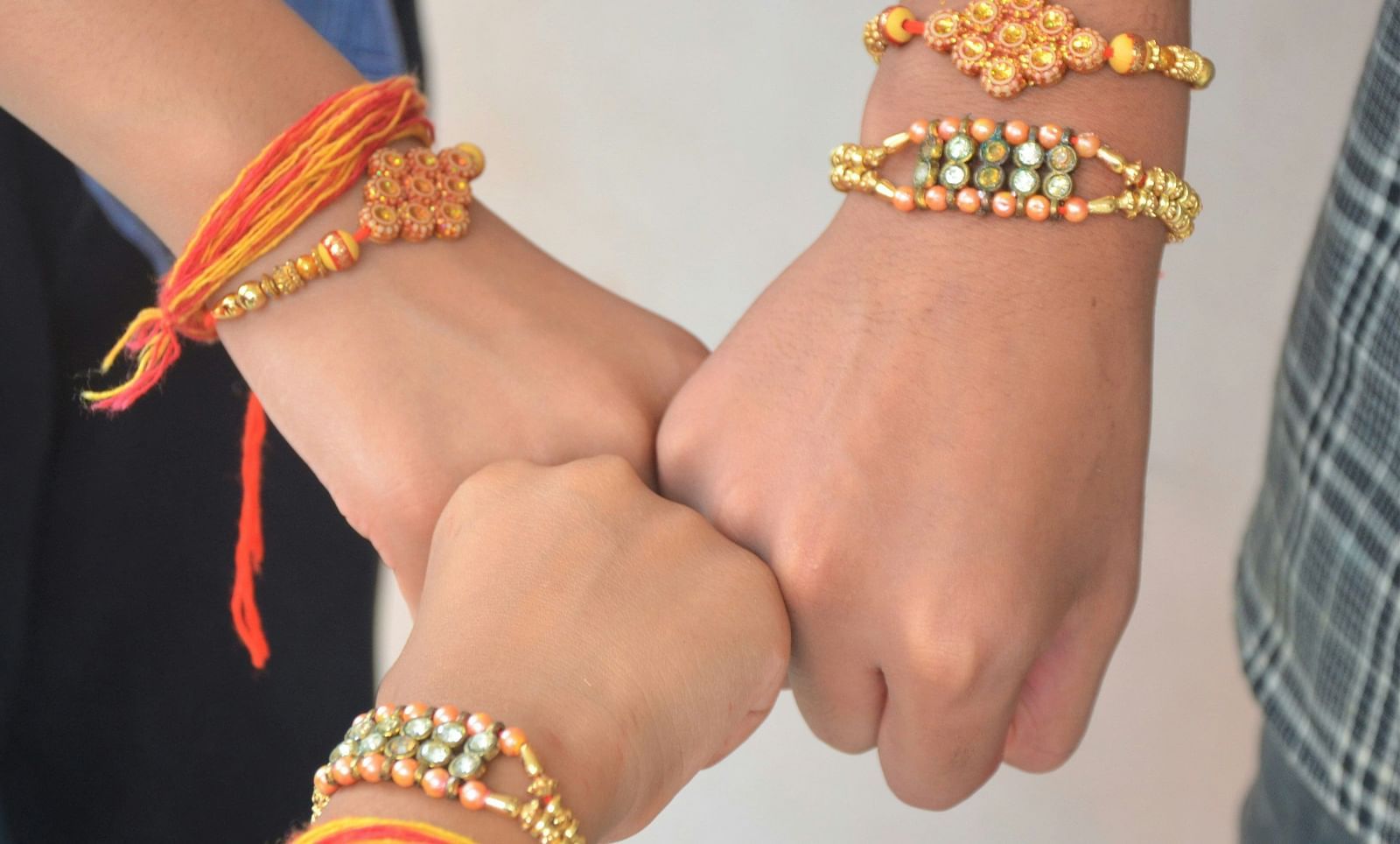
Lorem ipsum dolor sit amet, consectetur adipiscing elit
SA PARU
Bhaktapur's Lively Celebration of Life, Death, and Salvation
Sa Paru, also known as Gai Jatra, is a vibrant festival celebrated in Bhaktapur, primarily by the Newar community. This annual event honorus deceased relatives, with families parading through the city with chariots (Taha-sa) adorned with photos and belongings of the departed. The festival features traditional dances like Ghintang Ghisi, where participants engage in stick dancing, and includes humorous costumes and satire to celebrate life and accept death. Sa Paru typically occurs in August or September, lasting for about nine days, and is marked by a festive atmosphere throughout Bhaktapur.
The Bhailya Dya, or Bhairab, is a large chariot covered in straws symbolizing the deceased and leads the procession of smaller chariots (Taha-Sa). Guided by Ajima (Bhadrakali), the protective goddess, the Bhailya Dya is central to the celebrations, honouring those who have passed away in the past year. It underscores the connection between life and death, and is believed to assist the souls of the recently departed in attaining salvation (moksha) after the festival.
Main day is on 10 Aug 2025 (approx. depends upon the new lunar calendar) and extends up to Krishnashtami.
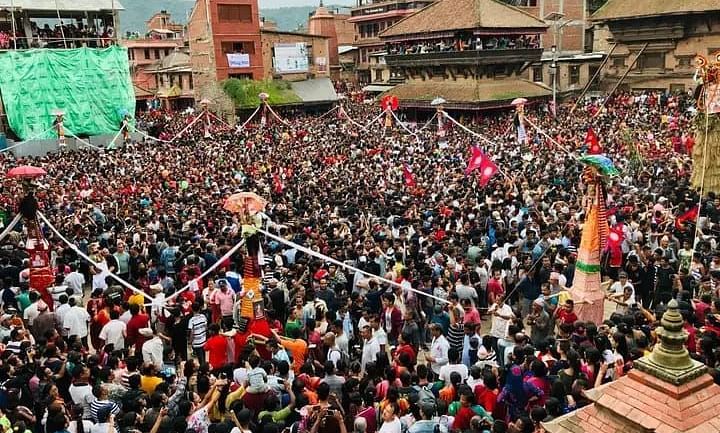
Lorem ipsum dolor sit amet, consectetur adipiscing elit
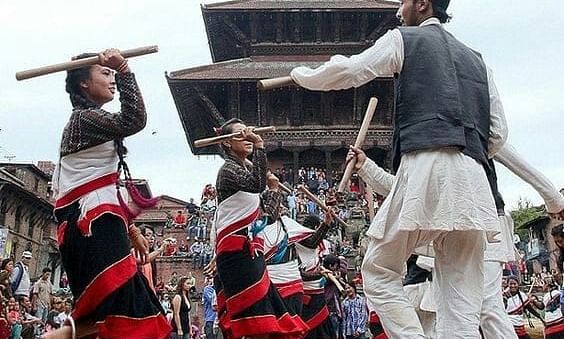
Lorem ipsum dolor sit amet, consectetur adipiscing elit
)
Lorem ipsum dolor sit amet, consectetur adipiscing elit
)
Lorem ipsum dolor sit amet, consectetur adipiscing elit
KRISHNA JANMASHTAMI
Witness Bhaktapur’s Heritage Shine in the Deep Prajwalan Yatra
Krishna Janmashtami is a major Hindu festival celebrated across Nepal, including the historic city of Bhaktapur. The festival marks the birth of Lord Krishna, an incarnation of the god Vishnu. In Bhaktapur, the celebrations feature the placement of oil lamps at various spots throughout the city. Families and communities gather to light these lamps as an offering to Lord Krishna. As with Krishna Janmashtami celebrations across Nepal, the people of Bhaktapur observe fasts and sing devotional songs honouring Lord Krishna's birth.
The Oil Lamp Procession, or Deep Prajwalan Yatra, significantly contributes to the cultural identity of Bhaktapur by embodying local traditions and communal values. This unique celebration during Krishna Janmashtami involves participants carrying oil lamps while circumambulating the city, symbolising devotion and community spirit. The procession showcases traditional attire, with women in "Haku Patasi" and men in "Daura-Suruwal", reinforcing cultural heritage. It also features music and dance, enhancing the festive atmosphere and fostering community bonding to promote. This annual event not only preserves cultural practices but also strengthens Bhaktapur's identity as a hub of Newari culture and spirituality.
16 August 2025 (approx. depends upon the new lunar calendar)

Lorem ipsum dolor sit amet, consectetur adipiscing elit
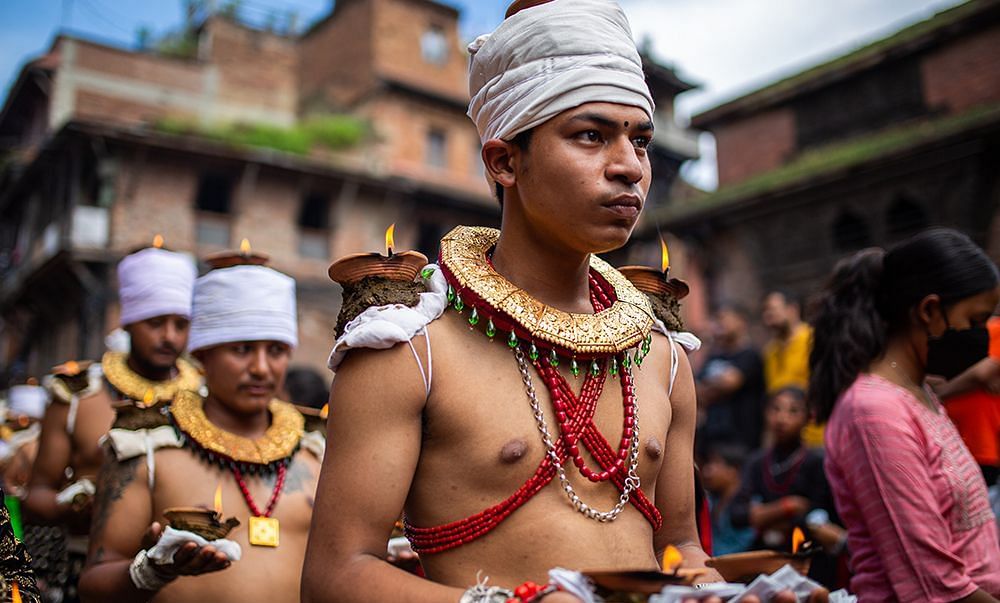
Lorem ipsum dolor sit amet, consectetur adipiscing elit
GATHAMUGA CHARHE
Beginning of the Festive Season
The Gathamuga festival, which was celebrated on August 2, 2024, by the Newar community in Bhaktapur, is a highly significant cultural event. This festival, deeply rooted in ancient traditions, serves as a symbol of community unity and gratitude for the blessings of agriculture. Gatha Muga Charhe symbolises the sign of the beginning of the festive season. Plus, the start of the reincarnation process of Nava Durga deities.
After Bhagasti, people start to get busy with rice plantations and other agricultural work. Within that monsoon period, playing musical instruments gets sidelined due to their busy schedules. The city of festivals, music, and dance abruptly turns out into an agro-focused city. Thus, this day (Gathamuga) as the first festival of the year, again connects everyone with their musical instruments.
Gathamuga holds great cultural importance within the Newar community, as it represents the triumph of good over evil. Celebrated on Shrawan Krishna Chaturdashi, the festival involves the burning of a three-legged effigy of the demon Ghantakarna, who was known for kidnapping individuals and demanding ransoms. This symbolic act signifies the community's victory over malevolent forces and is accompanied by purification rituals, such as cleaning homes and offering traditional foods like Samaybaji. Furthermore, Gathamuga not only marks the conclusion of the rice planting season but also serves as a precursor to upcoming festivals, strengthening community bonds and reinforcing cultural identity.
23 Aug 2025 (approx. depends upon the new lunar calendar)
)
Lorem ipsum dolor sit amet, consectetur adipiscing elit
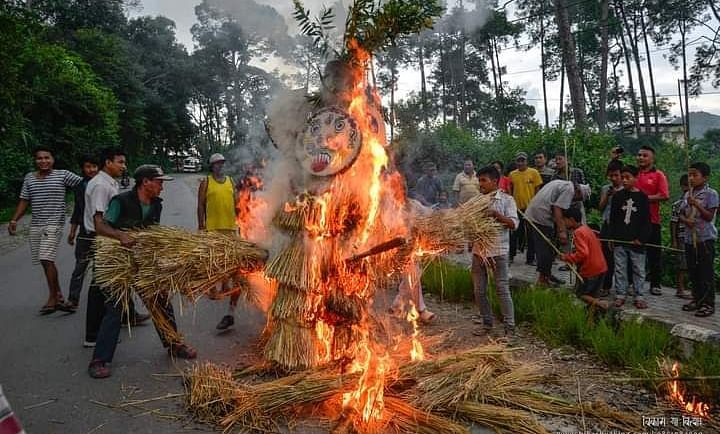
Lorem ipsum dolor sit amet, consectetur adipiscing elit

Lorem ipsum dolor sit amet, consectetur adipiscing elit
GUNLA PARVA
Bhaktapur’s Sacred Rituals and Music Come Alive
Gunla Parva is the tenth month in the Nepal Sambat lunar calendar, corresponding to August in the Gregorian calendar. It is a holy month for Newar Buddhists, who observe it by reciting scriptures, observing fasts, and visiting places of worship while playing devotional music. During the whole month, Buddhists go and visit different monasteries like Namo Buddha, Swyambhunath, Boudhanath, Bajrayogini, and many other big and small monasteries. Gunla Parva is one of the most important events in Newar Buddhism. The practice of observing the sacred month is descended from the rains retreat started by the Buddha, when monks stayed in one place and taught the Dharma. Gunla Parva is seen as an opportunity to accumulate Dhamma (religion) by Buddhists of all three sects - Hinayana, Mahayana, and Vajrayana.
In Bhaktapur, Gunla Parva features unique traditions distinct from other regions. Key practices include: Panchadan Ritual: On the last day of Gunla, five sacred items (rice, unhusked rice, salt, money, and pulses) are donated, often sourced from personal harvests. Gunla Baja: A special musical ensemble, the Gunla Baja, is played throughout the month, enhancing the festival's atmosphere. Procession of the Five Buddhas: The Five Buddhas are brought to Taumadhi Square, accompanied by traditional music, marking a significant cultural celebration.
31 August 2025 (approx. depends upon the new lunar calendar)

Lorem ipsum dolor sit amet, consectetur adipiscing elit

Lorem ipsum dolor sit amet, consectetur adipiscing elit
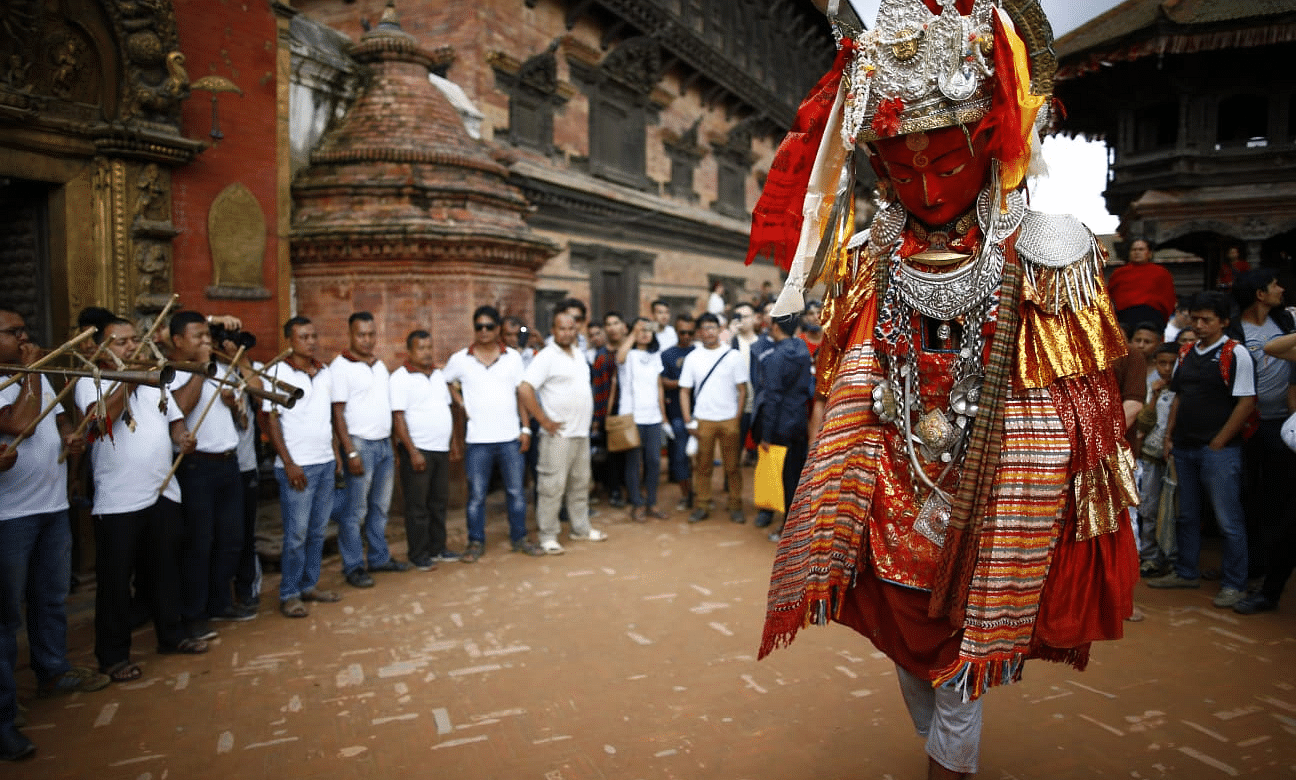
Lorem ipsum dolor sit amet, consectetur adipiscing elit
TEEJ
A Vibrant Celebration of Tradition and Devotion
Teej, a significant Hindu festival, is celebrated with great fervour in Bhaktapur, Nepal. This vibrant festival, primarily observed by women, marks a time of devotion, fasting, and communal celebration. Teej, also known as Haritalika Teej, is dedicated to the Goddess Parvati and her union with Lord Shiva. The festival, which falls in August or September, symbolises marital bliss and the well-being of spouses. Women celebrate by fasting, dressing in red or green sarees, and participating in various rituals.
Women, adorned in traditional red sarees and jewellery, gather in temples and public squares. The celebrations often start with a procession where women sing devotional songs, dance, and perform rituals to honour Goddess Parvati. The energy is palpable as the streets fill with vibrant colours. Observing a strict fast is a key component of Teej. Women abstain from food and water to pray for the longevity and prosperity of their husbands. In Bhaktapur, this devotion is evident as women participate in pujas (prayer ceremonies) at temples dedicated to Shiva and Parvati.
6 September 2025 (approx. depends upon the new lunar calendar)
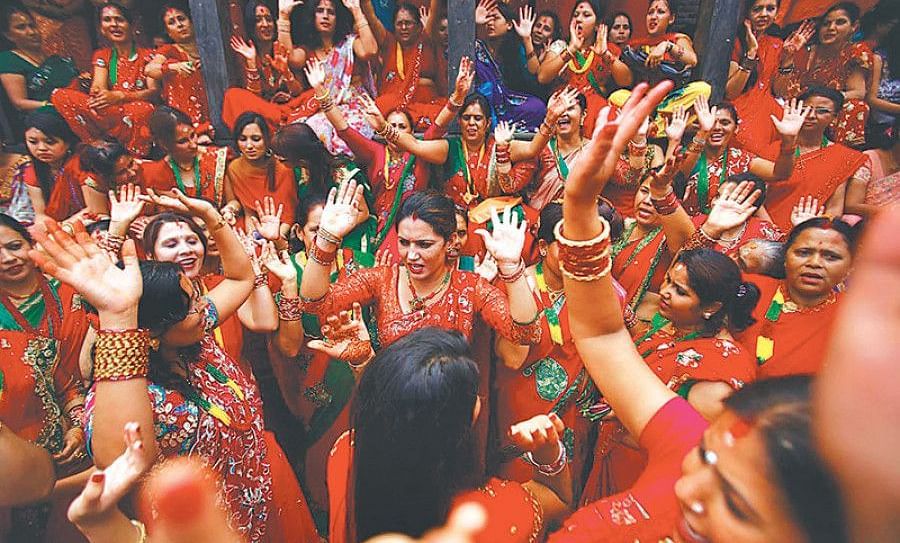
Lorem ipsum dolor sit amet, consectetur adipiscing elit
)
Lorem ipsum dolor sit amet, consectetur adipiscing elit
)
Lorem ipsum dolor sit amet, consectetur adipiscing elit
INDRA JATRA
Immerse in Bhaktapur’s Indra Jatra: Ancient Rituals Ignite Harvest Spirit
'Indra Jatra', also known as 'Yenya Punhi', is a significant religious festival celebrated by the Newar community in Bhaktapur, Nepal. This festival honours Lord Indra and marks the beginning of the harvest season. The celebrations start with the installation of a pole representing Yama, the god of death, at various locations in Bhaktapur, symbolising the onset of the festival. One of the key events is the Indrayani Jatra, where Goddess Indrayani, Lord Indra's consort, is worshiped and paraded through the city before being taken to Siddhapokhari. During the festival, devotees gather at Siddhapokhari to bathe and worship the image of Indrayani, in what is known as Yenya Punhi or the Shiddhapokhari Mela.
A unique feature of the festival is the Pulu Kisi procession, which signifies the conclusion of Indra Jatra. The Pulu Kisi, a mythical elephant figure, is paraded through the city, behaving mischievously and symbolizing the chaos and challenges faced during the festival. According to local folklore, the Pulu Kisi interacts with Mupatra, a demon, leading to a symbolic battle that highlights the theme of good versus evil. This procession not only marks the festival's end but also serves to honour local deities and strengthen the community's connection through shared cultural narratives and rituals.
15 September 2025 to 21 September 2025 (approx. depends upon the new lunar calendar)
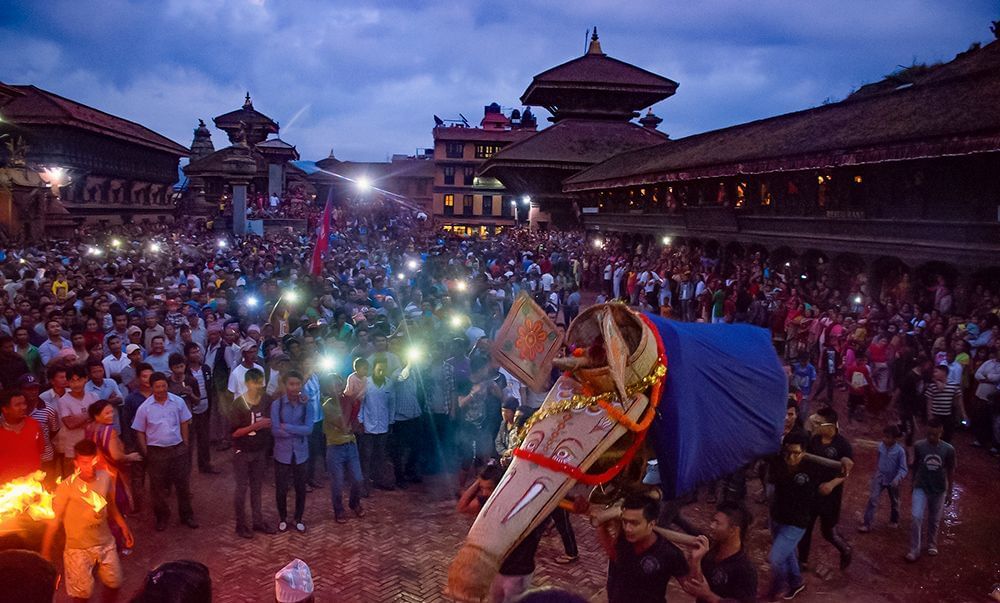
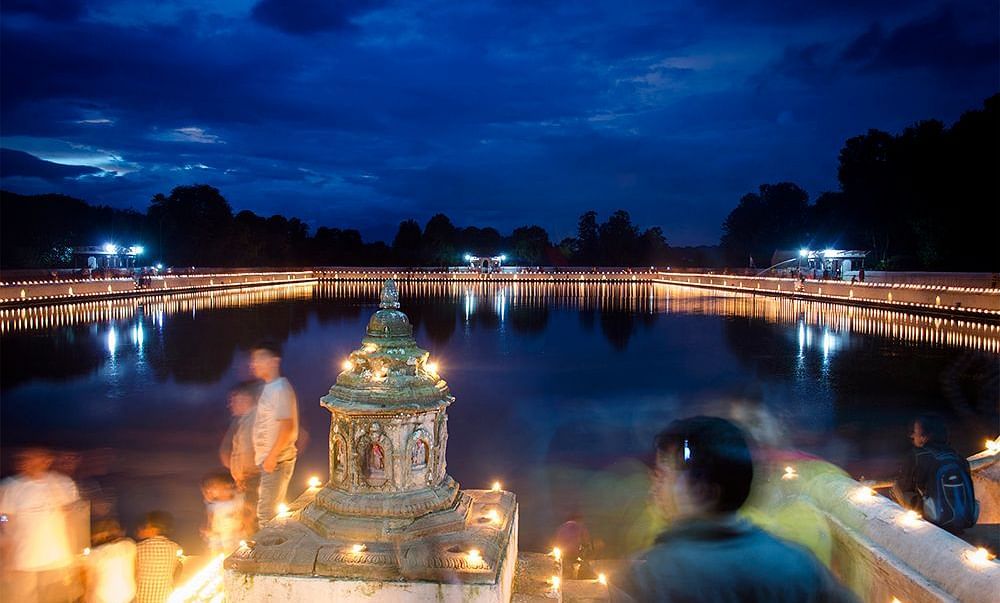
MOHANI
A Celebration of Heritage and Sacred Rituals
Mohani, celebrated primarily by the Newar community in Bhaktapur, is analogous to the larger Dashain festival in Nepal. This two-week celebration marks the onset of the festive season, beginning with the planting of barley seeds (Jamara) and culminating in family gatherings, feasts, and rituals honouring the Nava Durga deity. The festival's observances include lighting oil lamps at temples, participating in sacred dances, and taking part in processions, all of which emphasise family unity and cultural traditions, showcasing the rich heritage of the Newar people during this joyous period. Unique to Bhaktapur, the appearance and disappearance of the Nava Durga Deity is a ritual exclusive to Mohani. The festival starts with Nalāswane, where barley seeds are planted in sand, symbolising the beginning of the festivities.
On Ashtami, the communal feast Kuchhi Bhoy brings families together to enjoy traditional Newari food, reinforcing family bonds. On Navami, a special kohl-like tika, Mohani Sinha, made from soot collected from a butter lamp, is prepared and applied, believed to impart supreme knowledge. The Khame Jatra, a ritual involving the symbolic sacrifice of a buffalo representing the demon Mahishasura, is performed in Bhaktapur. Throughout the festival, the Navadurga Dance plays a significant role, with masked performances reenacting the victory of Goddess Durga over demons, symbolising the worship of the different forms of the Goddess Durga, known as the Navadurga deities. These dances are believed to protect the city from calamities and bring prosperity, reviving ancient traditions that connect the community to their historical roots. On Dashami, Newars perform the ritual of tying Kwakha, a red and white cloth thread, to the tika receiver's neck as a blessing, in addition to applying tika. The Mohani rituals underscore the theme of self-sacrifice, with animals being sacrificed only after their permission is obtained through a ritual, highlighting the deep spiritual and cultural significance of the festival.
3 October 2024 to 15 October 2024 (approx. depends upon the new lunar calendar)
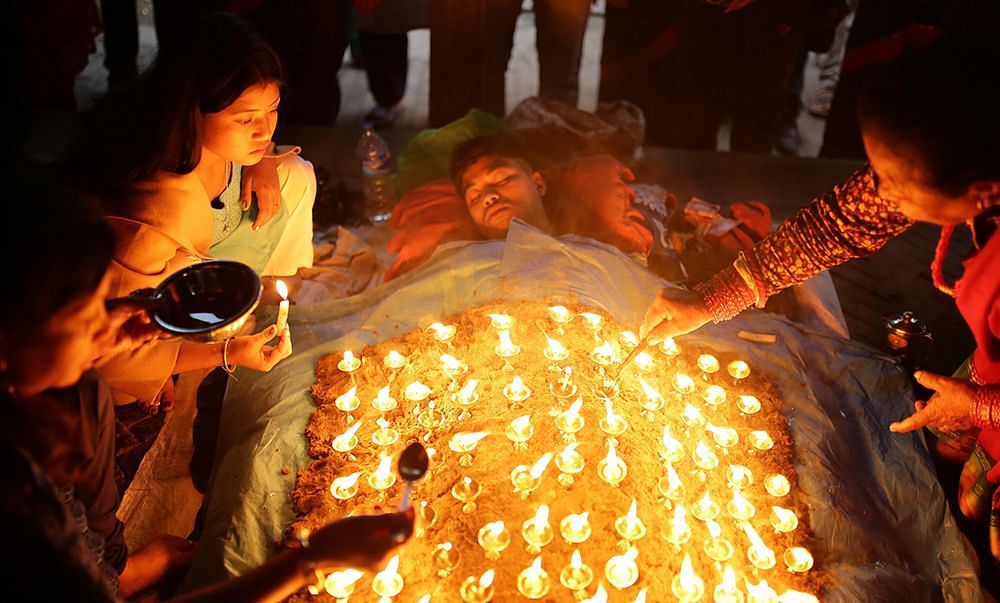
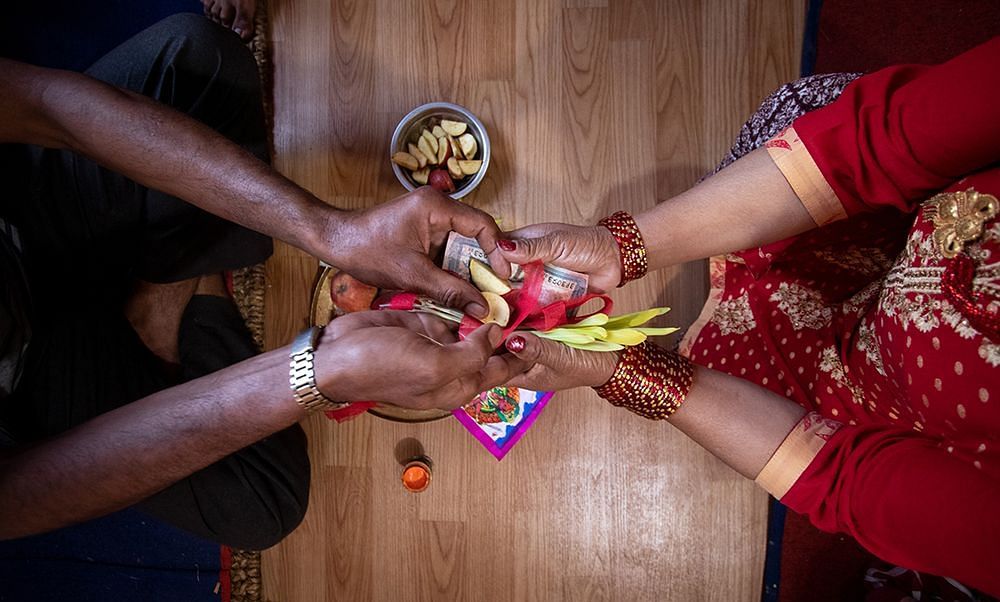
SWANTI
Illuminate the New Year: Newar Traditions Usher in Prosperity and Joy
Swanti or Tihar, celebrated primarily by the Newar community in Bhaktapur, is a five-day festival that parallels Diwali, placing a special emphasis on the role of women in households. This vibrant celebration includes rituals that honour crows, dogs, cows, and family members, reflecting deep cultural significance. The festival begins with Kwah Puja, where food is offered to crows, believed to be messengers of death. On the second day, Khichha Puja is performed to honour dogs, who are adorned with garlands and treats in recognition of their loyalty. The third day, Sā Puja, is dedicated to worshiping cows, followed by Lakshmi Puja. During Lakshmi Puja, people make offerings of flowers, fruits, sweets, and light lamps or candles to seek the goddess's blessings for wealth, prosperity, and good fortune. Homes are thoroughly cleaned and decorated with colourful lights, with doors and windows left open in the evening to welcome Lakshmi. In addition to Lakshmi, other deities associated with wealth, such as Kubera, Saraswati, and Ganesha, are also worshipped on this day. According to Hindu scriptures, the Pradosh period (evening) during Diwali is considered an auspicious time for Lakshmi Puja. Lakshmi is believed to wander the earth on the evening of Lakshmi Puja, and lighting lamps and candles is meant to guide her and invite her blessings for the coming year.
During Swanti, the 'New Year of Nepal Sambat' is celebrated primarily through Mha Puja, which means 'worship of the self'. This ritual, performed on the fourth day of the festival, purifies and empowers participants, marking an auspicious beginning to the new year. Families create mandalas and present Sagan, a set of auspicious food items, symbolising prosperity and longevity. Celebrations also include cultural programs, showcasing Newar traditions, music, and dance, with greetings exchanged among community members, emphasising the significance of this lunar New Year in Newar culture. The fifth day of Swanti is known as 'Kija Puja' and is dedicated to brothers. Sisters honour their brothers with a ceremony where a mandala similar to the one used for Mha Puja is worshipped. They present them long-burning wicks (khelu itāh खेलु इता:) which are placed next to the mandala, and also sacred threads (kwokha क्वखा) and a basket of fruits (tahsibwa त:सिब्व) symbolising long life and good fortune. The sisters then offer Sagan to their brothers which consists of auspicious food items. The five items (wine, meat, fish, lentil cake, and egg) symbolise the five Tantric concepts of fire, earth, water, air, and space respectively. The brothers give gifts of cash and clothes in return. They are then treated to a lavish feast. The ceremony may be held at the sister's home or at the brother's home as per family tradition. There is a very popular myth about celebrating this festival which says that whoever participated in Kija Puja, will get long life and good health. Throughout Swanti, Bhaktapur is adorned with vibrant decorations, lights, and communal feasting, marking it as a significant cultural celebration in Nepal.
30 October 2025 to 3 November 2025 (approx. depends upon the new lunar calendar)
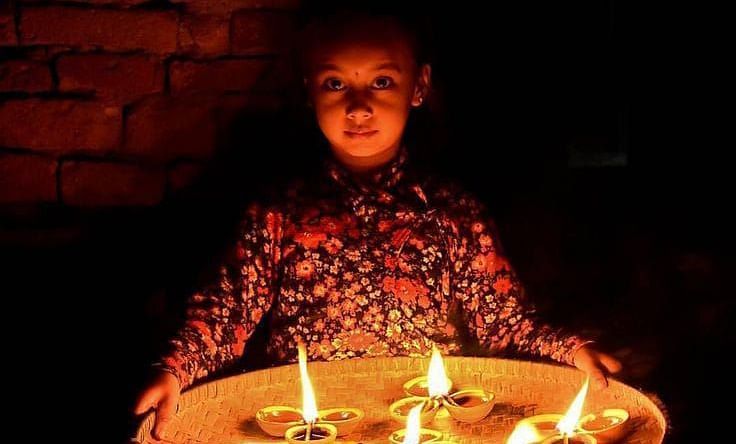
Lorem ipsum dolor sit amet, consectetur adipiscing elit
)
Lorem ipsum dolor sit amet, consectetur adipiscing elit
)
Lorem ipsum dolor sit amet, consectetur adipiscing elit
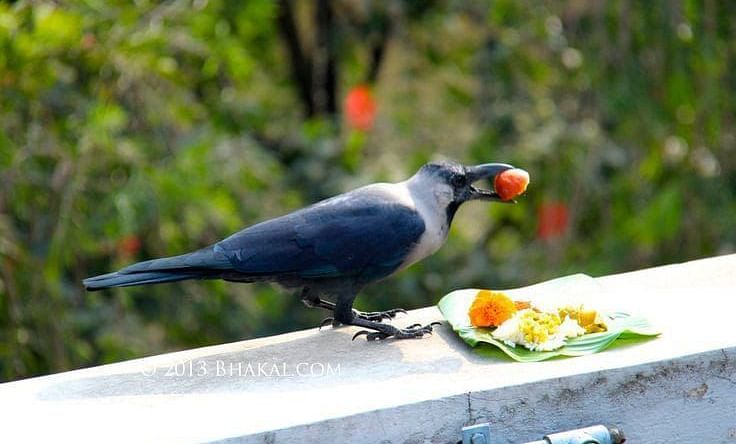
Lorem ipsum dolor sit amet, consectetur adipiscing elit
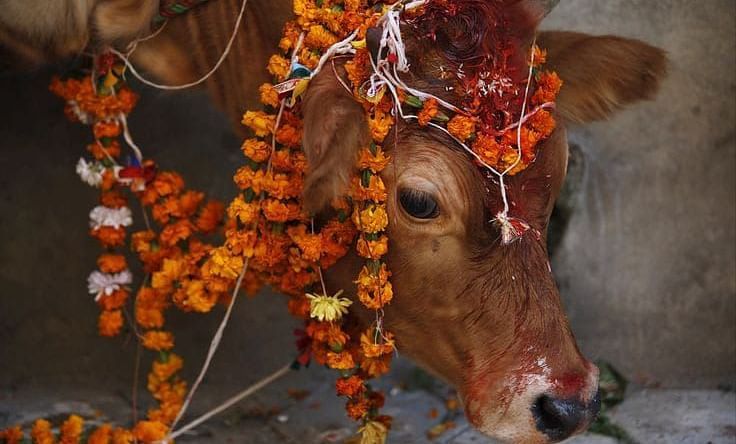
Lorem ipsum dolor sit amet, consectetur adipiscing elit
SAKI MANA PUNHI
Honouring Mother Earth Through Art and Tradition
Saki Mana Punhi, celebrated on the full moon of Kartik (October/November), is a minor festival significant to the Newa community in the Kathmandu Valley. It involves honouring Mother Earth by offering boiled arum roots, sweet potatoes, and fried grains at local temples. Festivities include traditional music, bhajans, and the creation of artistic grain figures, known as Halimali, displayed in front of temples.
This practice symbolises gratitude towards Mother Earth for the harvest, as families offer fried grains and root vegetables in reverence. The figures, often depicting deities and temples, reflect artistic expression and community bonding. The festival is also a time for singing bhajans and playing traditional instruments, enhancing communal ties and cultural heritage. This tradition, believed to be over 300 years old, serves as a reminder of the connection between agriculture, art, and spirituality in Newa culture.
15 November 2024 (approx. depends upon the new lunar calendar)
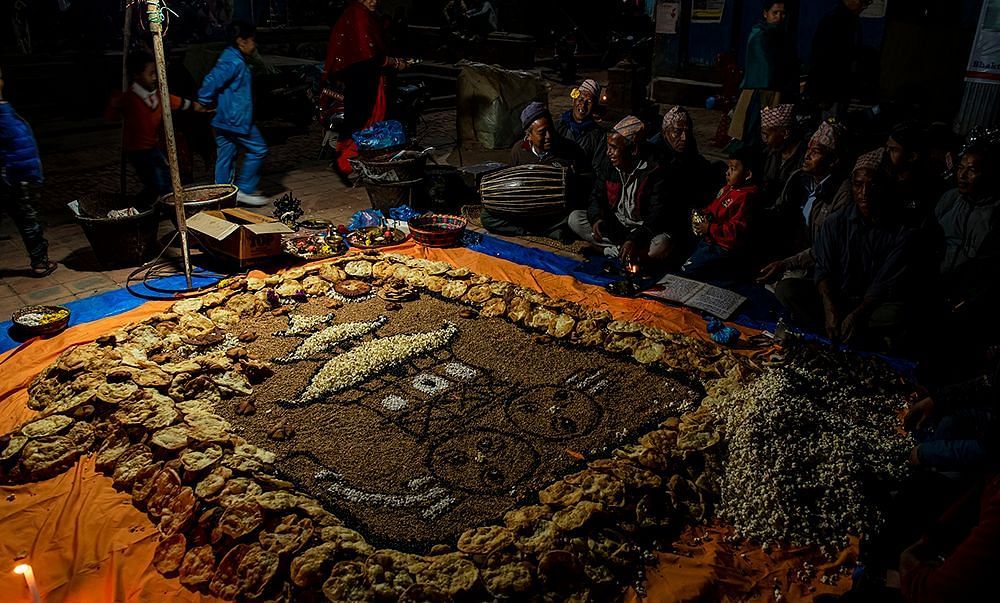
Lorem ipsum dolor sit amet, consectetur adipiscing elit
YOMARI PUNHI
Festival of Harvest, Gratitude, and Hope for a Bountiful Future
Yomari Punhi is a major festival celebrated by the Newar community in Bhaktapur, Nepal. It marks the end of the rice harvest season and is observed on the full moon day of Thinlã (the second month of the Nepali lunar calendar, usually in December). Yomari Punhi symbolises the new harvest by celebrating the culmination of the rice harvest season. The festival features Yomari, a delicacy made from rice flour derived from the newly harvested rice, filled with sweet ingredients like brown cane sugar and sesame seeds. This dish is offered to Annapurna, the goddess of grains, as a gesture of gratitude for the bountiful harvest. The preparation and consumption of Yomari during this festival reinforce the connection between the community's agricultural practices and their cultural traditions, marking a time of abundance and thanksgiving.
The Yomari shape is believed to take away the cold, and the longer the tail, the shorter the winter will be. Children sing a traditional song as they go from house to house asking for Yomari:
योमरी च्वामु उकी दुने हाकु ।
ब्युसा ल्यासे मब्युस बुढी कुटी
People prepare Yomari in various shapes, including gods and goddesses like Laxmi, Ganesh, Kubera, and Saraswati, and place them in a huge grain basket known as 'Silo' as a tribute to the gods.
15 December 2024 (approx. depends upon the new lunar calendar)
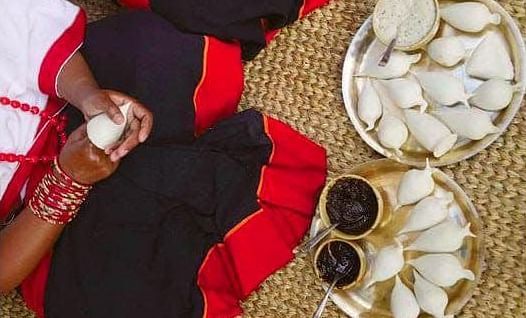
Lorem ipsum dolor sit amet, consectetur adipiscing elit
Explore Our Packages

CULINARY PACKAGE
Discover Bhaktapur's culinary delights with a Newari lunch, family dinner, and traditional cooking activity.
Note: To book packages, a minimum stay of 3 nights is required.
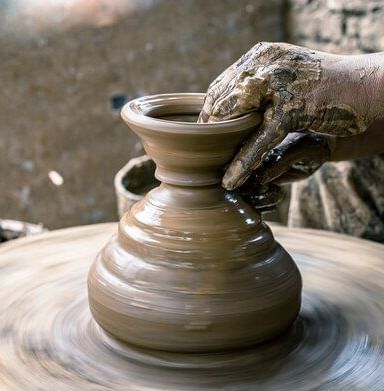
ART AND CRAFT PACKAGE
Engage in pottery making, thangka painting, and artisan visits with evening tours and rooftop dining nights.
Note: To book packages, a minimum stay of 3 nights is required.
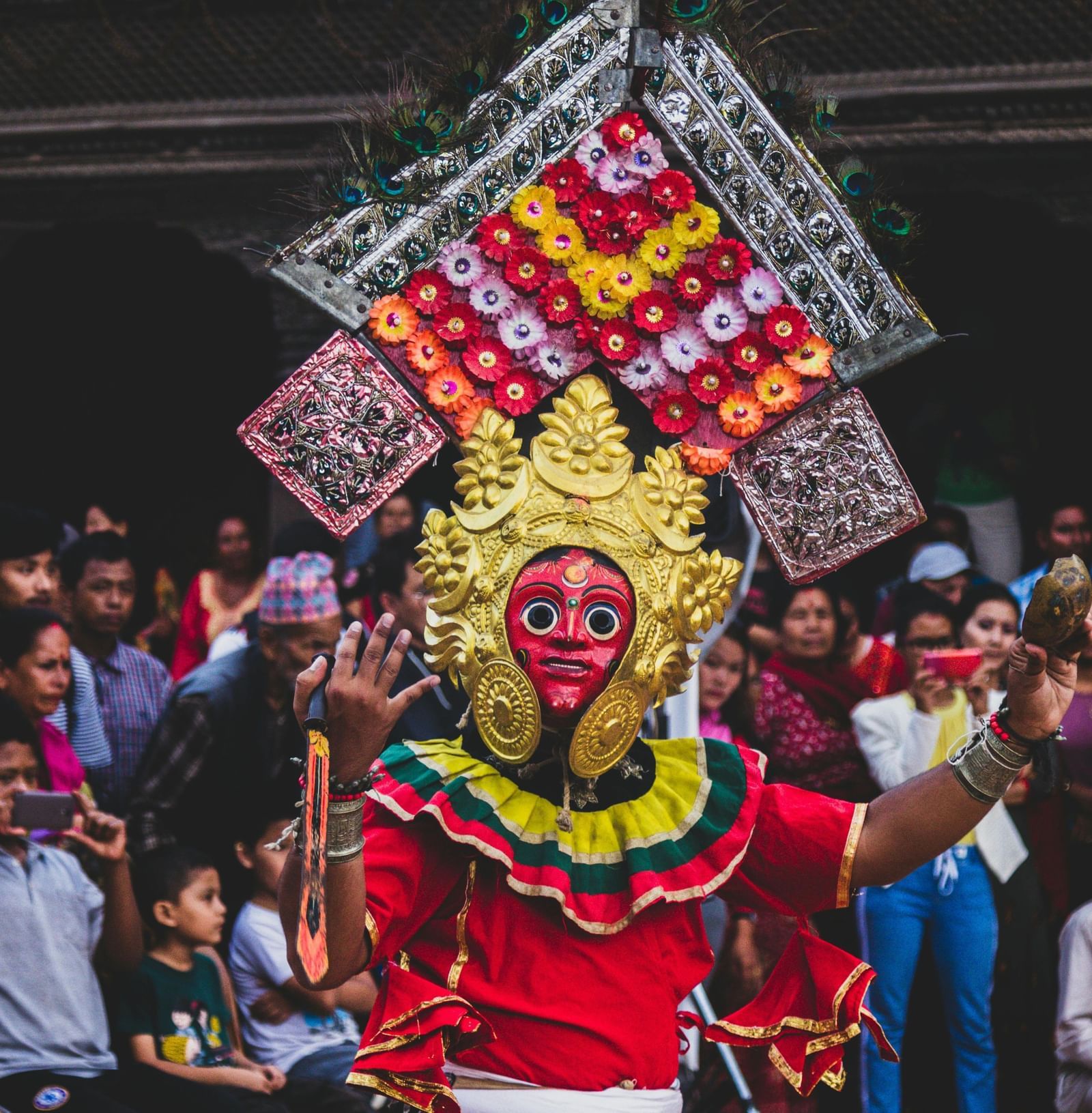
FESTIVAL PACKAGE
The Festival Package offers evening tours, rooftop dining, cultural festivities, and family meals for a memorable experience.
Note: To book packages, a minimum stay of 3 nights is required.
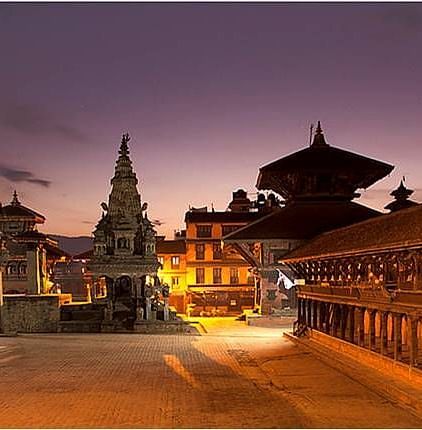
THE NANEE STANDARD SIGNATURE PACKAGE
Enjoy Bhaktapur’s evening charm, artisan visits, and culinary exploration with family dinners and rooftop experiences.
Note: To book packages, a minimum stay of 3 nights is required.
)
MONSOON BHAKTAPUR PACKAGE
Delight in Bhaktapur’s monsoon with evening tours, artisan visits, and a Newari cooking activity over two nights.
Note: To book packages, a minimum stay of 2 nights is required.
Explore Other Experiences

Morning Experience
Experience Bhaktapur’s mystical morning with temple rituals, bustling markets, and spiritual ambience. Feel the town's essence with serene sunrise views and local vibrancy.
EXPLORE
Evening with a Local Artisan
Engage with Bhaktapur artisans in their homes. Discover their craft while enjoying High Himalayan Tea and local delicacies.
EXPLORE
Bhaktapur by Evening
Stroll through Bhaktapur’s enchanting evening streets. Enjoy tranquil views, historical charm, and a wine and cheese pairing with our host.
EXPLORE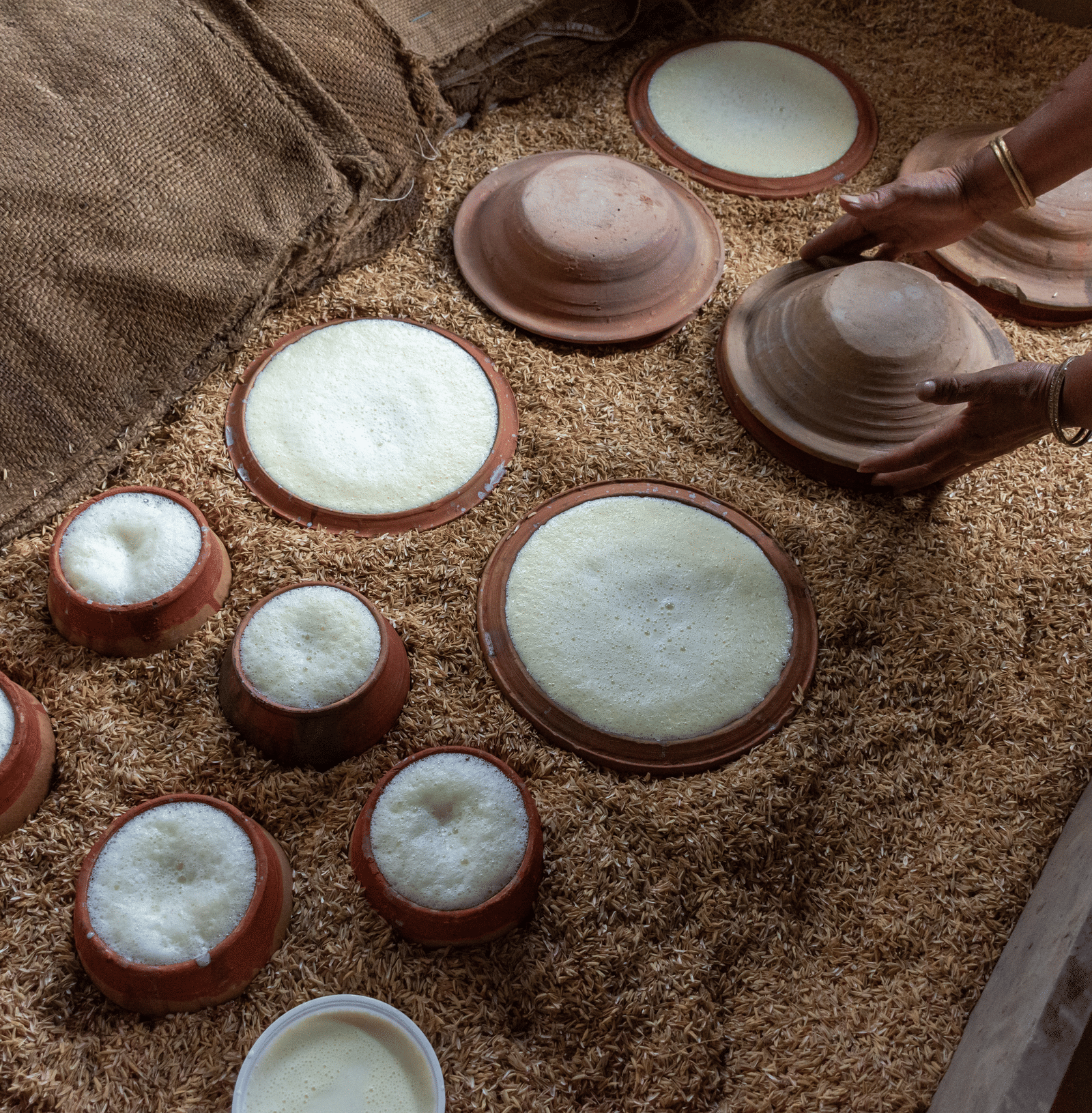
Culinary Exploration and Family Dinner
Join a local family for a culinary journey. Buy ingredients, cook together, and experience authentic Newari culture and cuisine.
EXPLORE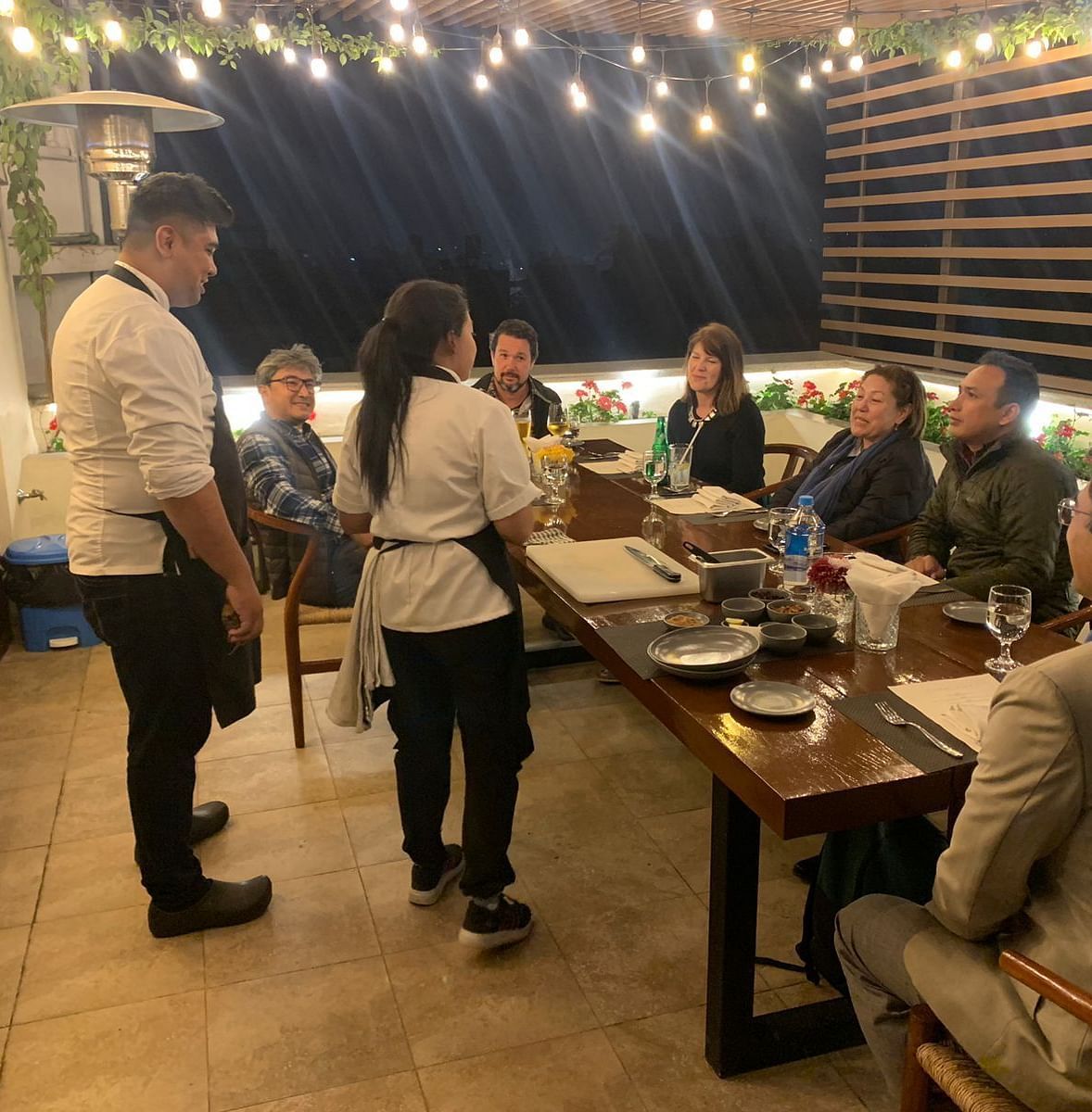
Chef’s Table Dinner
Experience a rooftop dinner with six to ten course Nepali cuisine. Enjoy local stories, stunning views, and high-end dining in an exclusive setting.
EXPLORE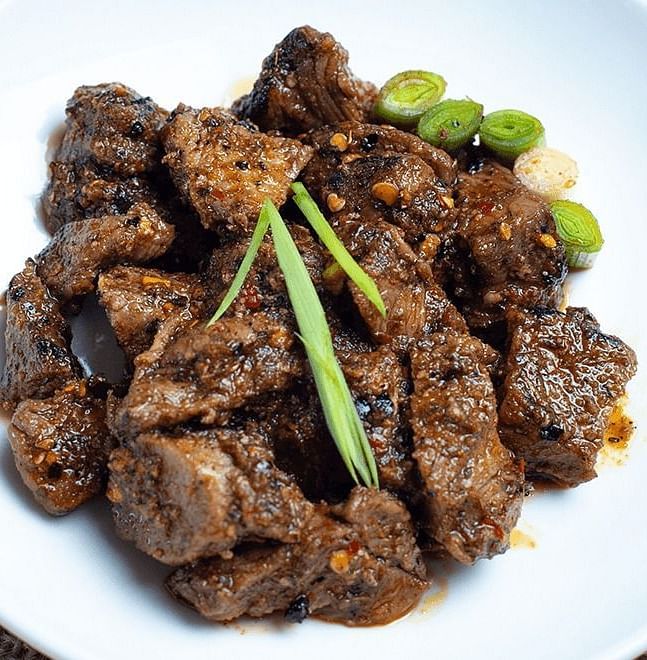
Traditional Newari Cooking Activity
Experience Newari culture through a hands-on cooking class featuring traditional dishes and cultural stories at The Nanee.
EXPLORE